Pathfinder Roleplaying Game Bestiary 2 by Fossilized Rappy
Achaierai to Azer
Original SA post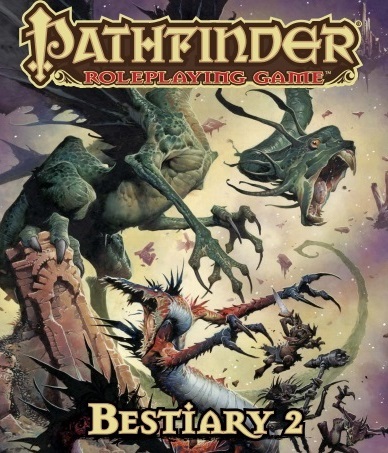
I had originally thought about doing two large letters per post, with more condensed in cases of short letters, but ultimately decided I'd mostly follow my predecessor with a letter per post, or more if it's a really short letter.
By the way, presuming you haven't already, you should probably read Alien Rope Burn's review of the Pathfinder Bestiary. Looking at my shit first would very much be watching the sequel before the original film.
Monsters: Achaierai to Azer
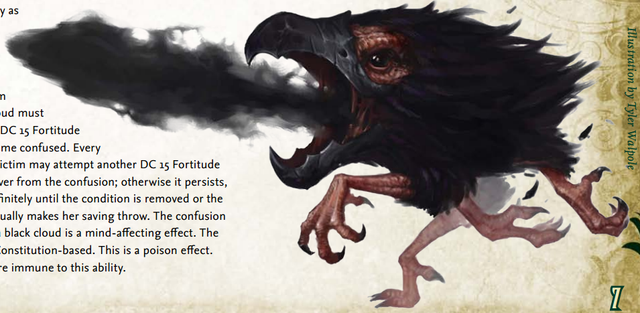
Achaierai (CR 5 Large Outsider [Evil, Extraplanar, Lawful])
While a lot of the beasties encountered in early Dungeons and Dragons drew their inspiration from mythology or Tolkienian fantasy fiction, there were some freakish entities that were purely the fever dream of good ol' Gary Gygax and company - the achaierai of 1981's original Fiend Folio is one such creature. Looking like it galloped out of Lewis Carrol's fever dreams, the achaierai is depicted as a freakish bird orb kept aloft on four long stilt-like legs, with little useless wings and a large beak attached to its borb body. After the Fiend Folio introduced them as being natives of the lower planes that were summoned to do evil, AD&D's Planescape would later bring them in as one of the natives of Acheron, a lower plane of endless warfare between infinite armies, and Third Edition would have these freakish fowl ascend to a position as one of the entries in the core Monster Manual.
Pathfinder's achaierai are not all that different from their creative ancestors. They are still tiny-winged borbs on stilts, they still dwell in the lower planes (Hell rather than Acheron, of course, as Acheron isn't Open Game Content), and they still hang around battlefields. Achaierais are pack hunters that work together to scatter foes and weed out the weakest prey, which they typically disembowl and eat alive since they are Evil. Other than their large beaks and talons, the main weapon these Outsiders have is their ability to barf toxic smoke clouds. These clouds deal 2d6 points of untyped damage that causes tissue necrosis and forces a DC 15 Fortitude save to avoid becoming confused. This confusion lasts until you succeed on the save, which is definitely a relief to those who might recall the days of yore when it was a flat three hour duration if you failed the save.
Aeons
Named after a concept in Gnostic theology of active spiritual emanations that come from the Godhead/Monad, aeons are just as much forces of nature as they are monsters. They are True Neutral custodians of the multiverse, correcting things that stray from some manner of grand plan that even the gods don't seem privy to. An aeon doesn't really care about any moralistic quandries or pleas from outside forces. It creates if the great oneness wishes for it to create, destroys if it is to destroy, and no one can persuade it otherwise. Aeons form no bonds or memories, and if they are killed they simply have their matter recycled into a new aeon
Akhana (CR 12 Medium Outsider [Aeon, Extraplanar]): Akhanas (Hindi for oneness or wholeness) have the appearance of four gray arms coming out of a human-sized galaxy, which is pretty standard for the funky star stuff aesthetic aeons have going for them. Their particular jurisdiction in the aeon heirarchy is the power of life and death. To this, they can cast spells like Cure Serious Wounds, Inflict Serious Wounds, Slay Living, and Raise Dead. How do they decide who lives and who dies? Nobody knows! There don't even seem to be any ground rules like "undead are unfairly living past their time" or anything, they just show up and heal or harm people without any explanation.
Bythos (CR 16 Large Outsider [Aeon, Extraplanar]): Somewhat larger four-armed cosmos blobs. The bythos are all about traveling through time and space. Their preferred method of fixing planar rifts and other mucking about with the stream of reality is to kill you dead in retribution. Their plethora of punches deal 1d6 bludgeoning damage, 1d6 cold damage, and force a DC 24 Fortitude save to avoid suddenly aging decades and thus going up an age category. They also can force Fortitude saves of the same measure in other fun ways, such as a gaze attack that causes 1d4 rounds of confusion or a touch that pops you 1d4 rounds into the future.
Paracletus (CR 2 Small Outsider [Aeon, Extraplanar]): While their name comes from a Latin term for spiritual helpers, these little shits are far from helpful most of the time. They are the representatives of logic and emotion, which somehow translates to finding characters with high Charisma or Intelligence scores and cranking up their 3/day aura power. This aura power forces a DC 12 Will save and can cause the emotions of anyone in a thirty foot radius to have a heavy influx of courage (casting of the Bless spell), fear (casting of the Bane spell), empathy (+2 to Bluff, Diplomacy, and Intimidate checks), apathy (-2 to those three skills), hope (+2 to Will saves), or despair (-2 to Will saves). In spite of the normally inscrutable nature of aeons, paracletus can be commandeered as an improved Wizard's familiar and be told to use specific emotion auras.
Pleroma (CR 20 Large Outsider [Aeon, Extraplanar]): Oh hey, an aeon named after the all-encompassing divinity and power of God. I bet you're going to be shocked that something with that kind of a title is ridiculously powerful! Pleromas look like Ringwraith cosplayers that got their cloaks dumped in glitter, and are the arbiters of the Big Concepts: namely, the forces of creation and oblivion. They show up whenever they feel the need to egg on an event that restores balance between the two, and are all too willing to obliterate anyone that gets in their way. To this end, their punches deal 20d8 of negative energy or positive energy damage, can summon either a magic terraforming sphere or a Sphere of Annihilation, and have a massive laundry list of spells that include Rusting Grasp, Fabricate, Major Creation, Disintegrate, Wish, Implosion, Cloak of Chaos, Shield of Law, Holy Aura, Unholy Aura, Geas, and Magic Circle against every alignment.
Theletos (CR 7 Medium Outsider [Aeon, Extraplanar]): Theletos look like akhanas, just with eight arms instead of four, and are the aeons of freedom and fate. Somehow, fate translates to slavery. That isn't slavery in a metaphysical sense, like being a slave to destiny or whatever, mind you...it's literal slavery. Theletos work to free slaves in slave-heavy states and actively encourage slavers and mind control magic in areas where slavery has been abolished. They have spell-like abilities including Augury, Bestow Curse, Remove Curse, Touch of Idiocy, Charm Monster, and Command.
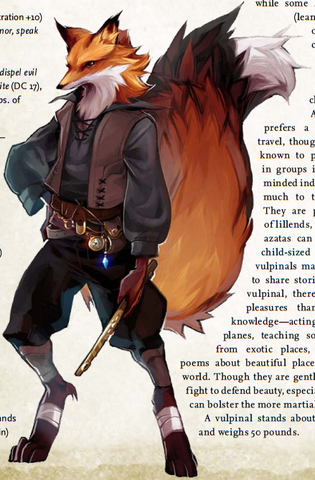
Agathions
The agathions of Nirvana are Neutral Good Outsiders to archons' Lawful Good and azatas' Chaotic Good. Or more accurately, the furry Neutral Good Outsiders, as angels are also Neutral Good but decidedly less animal-like. If you are familiar with older editions of Dungeons and Dragons and Planescape in particular, you might know these guys by their copyrighted name of guardinal. For whatever reason, the avoral and leonal were the only guardinals that made it into the 3E Monster Manual and thus Open Game Content territory, and for yet some other reason Paizo decided that the guardinals were just too good to pass up bringing back. While not relevant to their portrayal here, the term "agathion" is traditionally used for a demon/spirit familiar that is magically bound to an object, which makes it funny that it of all things was the new name for the guardinals.
Avoral (CR 9 Medium Outsider [Agathion, Extraplanar, Good]): Gruff eagle men that act as the messengers, scouts, and spies for the agathions. They also happen to be the vanguards of agathion conflicts, casting Dimension Door to allow their fellow celestials passage. Avorals are also capable of casting Blur and Magic Circle Against Evil on themselves, as well as several offensive spells such as Hold Person, Lightning Bolt, and Magic Missile.
Cetaceal (CR 15 Medium Outsider [Agathion, Aquatic, Extraplanar, Good]): Cetaceals could easily be confused for orca merfolk, were it not for the fact that the orca skin continues up onto their humanoid half. If you are a Neutral Good hero who is either of an aquatic race or happens to die underwater while fighting evil, there's a chance your soul will be reshaped as a cetaceal, which means you get the job of fighting evil aquatic beings like sahuagin and aboleths. On top of spell-like abilities including Lightning Bolt, Hold Monster, Greater Teleport, Cure Serious Wounds, and Cone of Cold, the cetaceal is capable of letting loose a massive area of effect attack once per day. This burst covers a one hundred foot radius, dealing 17d6 damage that is half cold damage and half electricity damage.
Draconal (CR 20 Large Outsider [Agathion, Extraplanar, Good ):[/B] The anthropomorphic dragons known as the draconals are the mightiest agathions. This, of course, translates to having lots of magic power. A draconal has both the spellpower of a level 17 Cleric and spell-like abilities such as Plane Shift, Control Weather, Lightning Bolt, and Hold Monster. A Strength score of 36, Constitution of 27, spell resistance 31, regeneration 10, and damage resistance 15 isn't exactly shabby either. Don't expect them to help you if you are a group of heroes, though, because draconals are aloof and focused on the long game of the lower vs. upper planes rather than individual conflicts.
Draconals have specific breath weapons, gender energy balance (in the Chinese Yin-Yang sense), and focuses based on their scale color: black draconals have male and female energies in balance, focus on the celestial realm and immortality, and breathe fire, green draconals are slightly masculine, focus on plant life, and have cold damage breath, red draconals are strongly masculine and known for being aggressive, focus on fire and light, and breathe fire, white draconals are strongly feminine and known for being serene, focus on metal and purity, and have cold breath, and yellow draonals are balanced gender-wise, focus on stone and fortune, and breathe acid.
Leonal (CR 12 Medium Outsider [Agathion, Extraplanar, Good]): Noble, majestic, ferocious, and brave: real lions are only two of these things, but the leonals are all four. While they are bog standard anthropomorphic animals in appearance, leonals are definitely the most beastly of the agathions, hunting the forces of evil in prides and eschewing manufactured weaponry in favor of ripping demons and devils apart with their bare claws and teeth. This seems odd when you are innately able to cast Wall of Force and Fireball to aid yourself in combat, but it is what it is. They also happen to be convenient combat medics, being capable of casting Cure Critical Wounds, Neutralize Poison, and Remove Disease as spell-like abilities.
Silvanshee (CR 2 Tiny Outsider [Agathion, Extraplanar, Good]): Silvanshees look like thin black cats and more or less exist because someone wanted a celestial on the Improved Familiar list. Some mortals think that silvanshees are actually shapeshifted witches or dark fey, which the silvanshees haven't tried to correct for whatever reason even though it would help with their reputation. While they are very much not physically strong and their spell-like abilities are mostly little tricks like Prestidigitation and Dancing Lights, they can heal 1d6 damage once per day or grant an ally their Charisma modifier as a bonus to all saving throws for ten minutes, so I can't say that silvanshees are entirely useless to have around.
Vulpinal (CR 6 Small Outsider [Agathion, Extraplanar, Good]): Halfling-sized anthropomorphic fox agathions that are celestial bards and sages. A vulpinal likes to travel around, sharing songs and stories with celestials and mortals alike. A constant aura of Calm Emotions in a thirty foot radius ensures that these performances are typically serene ones as well. Vulpinals primarily fight against evil to protect what they find beautiful, and can use spell-like abilities such as Flaming Arrow, Holy Smite, and Mage Armor to do so.
Akata (CR 1 Medium Aberration)
Want an eldritch abomination, but your players simply aren't up for the challenge of the bigger baddies yet? Say hello to the akata, created as a starting level horrible tentacle beast from beyond. While it is described as looking like a hairless blue lion with tentacles where its mane should be, that doesn't quite emphasize how weird the creature looks, with its vaguely humanoid head that has glowing gold eyes and a jagged mouth (I say mouth because it has no teeth, just the serrated edges of its maw in a facsimile!) as its only features, oddly caricature-like three-clawed feet, and a build that honestly says "'roided out grayhound" more than "lion" in my mind. It's a very alien creature, which makes sense, given that it's actually extraterrestrial.
The akatas are actually from an unnamed destroyed planet, having survived by hibernating as they hurdled through space on asteroids that were once parts of their native world. After waking up, they immediately go to looking for both food and a place to raise their young. Unfortunately, that place happens to be inside humanoid bodies, as larval akatas are microscopic parasites that reside in their parents' saliva. A bitten humanoid has to make a DC 12 Fortitude save or contract Void Death, a disease that deals 1d2 Dexterity and Constitution damage per day. Those that can't eventually save against the disease or be cured will return from the dead as a void zombie. While void zombies use the stats of fast zombies from Pathfinder Bestiary with an added 1d6 damage tongue lash attack and blood drain, they are in fact just the meta puppets of the rapidly growing akata larvae, and that 'tongue' is actually the larva's feeding tentacle. Fortunately, akatas and their larvae are weak to the rather common Earth-like planetary element that is saltwater, which deals 1d6 acid damage on a splash or 4d6 if fully submerged.
Amoebas
Non-microscopic amoebas come in two flavors, giant (CR 1 Small Ooze) and swarm (CR 1 Fine Ooze [Swarm]). The former is a dog-sized version of the humble amoeba, while the latter is a big swarm of coin-sized amoebas, and each can transform into the other if conditions are right. Since the giant amoeba's slam deals 1d3 acid damage compared to the amoeba swarm's 1d6, it seems obvious which form would be more practical for them to take.
Amphisbaena (CR 4 Large Magical Beast)
The amphisbaeana's origins are in Greek mythology, where it was born from the blood of Medusa as it dripped onto the sands of the great sands of the Sahara. These children of the dead gorgon were serpents with a head on each end, possessing powerful venom even though their diet consisted of ants, and purportedly had many medicinal uses if killed and eaten. Later Medieval stories would extend the amphisbaeana's dietary repertoire to include carrion and live prey of a less insectoid sort. Certain Medieval drawings and sculptures would also give the amphisbaeana two or four eagle-like legs, dragon-like heads, and sometimes even functional wings.
Pathfinder's amphisbaeana is a massive viper with a head where its tail should be, known for being a relentlessly aggressive predator that attacks anything that enters its territory. They mainly prey on small animals and bite-sized humanoids such as gnomes and halflings, but will take down human-sized targets if they are particualrly hungry. As a wink and a nod to their mythological origin, amphisbaeanas are immune to petrification, making them popular pets for medusas. Each head packs a 1d8 damage bite that delivers a dose of venom that deals 1d3 Constitution damage if you fail a DC 14 Fortitude save, and if you get a critical hit with a slashing weapon the two halves of the amphisbaeana will split and function on their own.
Angels
Cassisian (CR 2 Small Outsider [Angel, Extraplanar, Good]): Cassisians are formed from the souls of particularly trustworthy and pious soldiers or fragments of dead angels and take the form of helmets (just what helmet a cassisian has depends on what god they serve, and can be anything from a simple leather cap to a samurai's kabuto) with wings. Man, imagine serving the gods of Good all your life as a Paladin and then it turns out you become a really weak floating bucket for the rest of eternity. Maybe it's not so bad, though, as your Intelligence score drops to 6, so you aren't exactly the sharpest tool in the shed anymore anyway. In spite of being only as smart as an ogre, cassinians have eidetic memories, and those that end up being familiars (because of course the angels need an Improved Familiar example too) typically recite random religious texts and moral platitudes to their master.
Monadic Deva (CR 12 Medium Outsider [Angel, Aquatic, Extraplanar, Good]): The devas in Pathfinder are a weird case of history repeating itself. Way back in edition Numero Uno, the astral, monadic, and movanic deva were handsome all-male angels that appeared in an issue of Dragon magazine and the Monster Manual II, and yet again for the Monstrous Compendium Outer Planes Appendix and the Planescape setting in AD&D Second Edition. For whatever reason, however, only the astral deva appeared in 3E's Monster Manual. The monadic and movanic devas appeared in the 3E Fiend Folio, as well as everyone's favorite Open Game Content underground railroad the Tome of Horrors. History would repeat itself again in Pathfinder, with the Pathfinder Bestiary only having the astral deva and the other two lagging behind to appear here.
Moving on past the history lesson, the monadic devas are muscular golden-winged angels that watch over the Ethereal Plane and the elemental planes. They act as envoys to non-Evil genies and elementals, keeping the peace between them and beating up evil elemental and ethereal entities. Their weapon of choice is an ornate +3 morningstar that they hold dear in a very anime way, naming them and proudly shouting said names in battle. If they manage to hit the same foe with their morningstar twice in one round, they get an extra 1d8+10 damage to that foe for free. Monadic devas also have your standard angely spell-like abilities such as Plane Shift, Remove Curse, Remove Disease, Remove Fear, Cure Serious Wounds, Holy Word, and Hold Monster.
Movanic Deva (CR 10 Medium Outsider [Angel, Extraplanar, Good]): Movanic devas are infantry and patrol officers like their monadic brothers, with their jurisdiction being the Negative Plane, Positive Plane, and Material Plane. Physically, they are slightly leaner than monadic devas and have jagged purple wings. They aren't really all that mechanically different either, to be honest – they are basically slightly weaker-statted monadic devas that have +1 flaming greatswords rather than big morningstars and exchange the monadic deva's extra damage special quality for animals and plants never initiating hostilities with them and immunity to any harmful effects of negative and positive energy.
Animate Dream (CR 8 Medium Outsider [Extraplanar, Incorporeal])
An animate dream is the incarnate fragment of the dream of someone with an extremely vivid imagination. Hungry for imagination and emotions, the animate dream seeks out mortals to feed on their fear and creative thoughts. To achieve this end, it has spell-like abilities such as Deep Slumber, Nightmare, Confusion, and Fear, as well as a touch attack that deals 6d8 negative energy damage and forces a DC 21 Will save to avoid contracting its nightmare curse. The nightmare curse deals 1d4 Wisdom drain (that's permanent drain, mind you, not regular ability damage) each day due to visions of confusion and terror flying through the victim's mind. Night hags often enslave animate dreams or kill them and use their essence in the creation of their heartstones.
Aranea (CR 4 Medium Magical Beast [Shapechanger])
The aranea is a rather storied legacy creature, having appeared in the famous First Edition adventure The Isle of Dread and in the Mystara setting as influential schemers on the Savage Coast. While they may look like particularly fat and hunchbacked monstrous spiders, araneas are actually extremely intelligent creatures capable of casting spells as a level 5 Sorcerer. Each aranea has a specific alternate form of some Small or Medium humanoid race that acts as an identifier for them as much as their base form does. They may live in small groups of their own kind deep in the wilderness and spend their time studying the arcane arts, or infiltrate humanoid communities and live peaceful lives therein doing much the same thing they would with other araneas. Araneas are actually quite reasonable creatures as long as you treat them nicely, and some will even teach you about magic if you give them a nice arcane object or do a favor for them. If you are hostile, however, araneas are capable of using both their spellcasting ability and their spider traits, namely sticky webs and a bite that conveys a toxin dealing 1d3 Strength damage per round. Araneas prefer to hold foes for ransom rather than kill them outright.
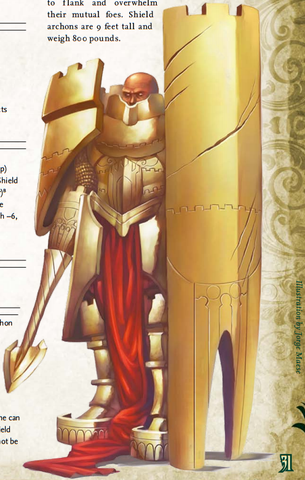
Archons
Having exhausted the Open Game Content legacy archons in the first Pathfinder Bestiary, both archons found here are completely original to Pathfinder. Fancy that!
Shield Archon (CR 10 Large Outsider [Archon, Extraplanar, Good, Lawful): Heavyset giants clad neck to toe in full plate armor, the shield archons are the defensive elements of celestial armies. They laugh in the face of disarm attempts, because they are their own armament – specifically, they can transform their hands into a +1 tower shield and a +3 shortspear or back again as a free action. While they can't be taken and used by anyone else, you can still sunder either of these items, which is probably both awkward and forces the star archon to take a full round action regenerating its busted hand(s). A shield archon can also swap places with a willing or unconscious ally within sight once per day, which is typically used to either shield a grievously injured ally or to act out a surprise flanking maneuver.
Star Archon (CR 19 Large Outsider [Archon, Extraplanar, Good, Lawful]):
Pathfinder Bestiary 2 posted:
Star archons are the tacticians and strategists of Heaven. Gifted with insight and powerful magic, they spend much of their time steering long-term plans for Heaven’s armies and good folk in the world.
Athach (CR 12 Huge Humanoid [Giant])
The word athatch is a Gaelic term that simply means "giant" or "monster". Dungeons and Dragons decided to spice things up a bit by having the athach be a vile mega-orc with a third arm twisting out of its chest. From First to Third Edition they clawed their way up to prominence, and they are back in Pathfinder in all their tall, tusked, and well-armed glory. The 18 foot tall athachs are Chaotic Evil to a fault, finding entertainment in destroying crops, tearing up cemeteries, and torturing their humanoid prey before finally eating them. They also hate other beings that are of similar size to them, either fighting them or fleeing from them depending on whether or not the situation seems like it is in the athach's favor. An athach's gross drool-coated bite imparts a poison that deals 1d4 Strength damage per round.
Attic Whisperer (CR 4 Small Undead)
Attic whisperers are the undead remnants of neglected children, formed out of a hodgepodge of a dead child's clothing, toys, and other discarded objects. They often wear the skulls of small animals, and are in fact compulsively led to find one after they are reborn, presumably because being a dead neglected child's spirit wasn't edgy enough on its own. The one thing an attic whisperer longs for is companionship, and it will attempt to steal away children to play with it forever and ever. Its touch forces a DC 16 Will save, failure of which allows it to steal the target's voice. Not only is the victim rendered mute for one hour, but the attic whisperer can then use their voice for whatever nefarious purposes it wishes to use them for. It can also just straight up bite you with its animal skull, forcing a DC 16 Will save to avoid being exhausted for an hour, or asleep for an hour if it bites a second time and that save is failed as well.
Aurumvorax (CR 9 Small Magical Beast)
The aurumvorax first appeared in 1980's Expedition to the Barrier Peaks, the weird and famous science fiction-meets-fantasy adventure that also gave us the froghemoth and vegepygmy. It is basically a wolverine with eight legs and golden fur. Like wolverines, aurumvoraxes are far more capable of fucking your shit up than their size alone implies, which is made even more painful by the fact that they have four forelimbs rather than two to do it with. They also eat precious metals in addition to meat, which puts them at direct odds with dwarves.
Axiomite (CR 8 Medium Outsider [Extraplanar, Lawful])
Pathfinder Bestiary 2 posted:
A particular axiomite may look like any humanoid-shaped creature, though the particular form does not affect its abilities in any way. Beneath this form, all axiomites are the same—clouds of glowing, crystalline dust that constant swirl and congeal into complex tangles of symbols and equations, making them literally creatures of pure mathematical law.

These guys are the native race of Axis the Eternal City, the plane of absolute Law that is a giant city sitting below the massive graveyard of the goddess of death. Three castes of axiomite exist: one for expanding the Eternal City, one for creating and repairing the Law robots known as inevitables, and one for learning more about the inherent formulae of the multiverse. While fighting isn't on their resume, they are armed for combat if the case arises, having +1 longswords and spell-like abilities such as Order's Wrath, Lightning Bolt, Dispel Chaos, and True Strike.
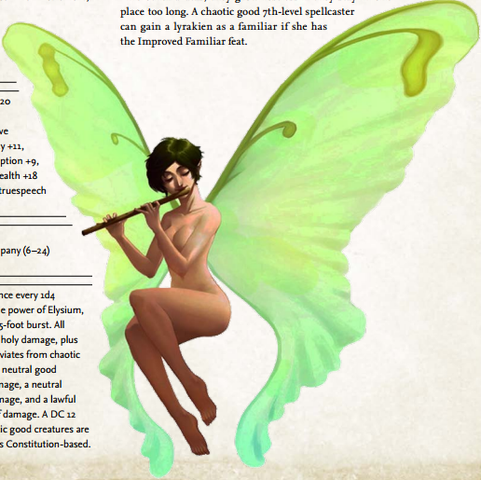
Azatas
The Chaotic Good celestials. Like the two new archons, the two new azatas here are entirely Pathfinder originals.
Brijidine (CR 17 Medium Outsider (Azata, Chaotic, Earth, Extraplanar, Fire, Good)
Sexy naked women made out of lava (insert your own 'she's hot' jokes here). Brijidines are stated to love basking in volcanoes, writing poetry, tending to the ill, and pursuing recipes for spicy food, and love to receive gifts of fireproofed copies of poems or exotic hot foodstuffs such as peppers. When not being all leisurely, these fiery celestials are capable of inflicting a lot of damage. A brijidine deals 6d6 fire damage to anyone that touches her and can freely summon an obsidian blade that acts as a +1 flaming burst keen longsword (that dissolves immediately after leaving the brijidine's grasp, of course), shoot a 16d6 fire damage lava glob with a range increment of 30 feet, and cast special versions of Meld Into Stone, Soften Earth and Stone, Spike Stones, Stone Shape, and Wall of Stone spell-like abilities that have the added effect of having the stone deal 1d6 fire damage per round to anything in a five foot radius for a minute's time.
Lyrakien (CR 2 Tiny Outsider [Azata, Chaotic, Extraplanar, Good]): Whimsical pixie-like azatas that love music and dancing. If you couldn't guess from their size and Challenge Rating, they are the azatas' Improved Familiar option. Lyrakiens are typically taken as familiars for those who want a traveling companion, as they are capabl e of removing all exhaustion and fatigue to anything that can hear their song once per day. Lyrakiens can also cast spell-like abilities such as Dancing Lights, Daze, Summon Instrument, and Cure Light wounds, as well as summon a ball of light every 1d4 rounds that deals 1d4 holy damage.
Azer (CR 2 Medium Outsider [Extraplanar, Fire])
Azers are supposedly named after a Persian word for fire, but no Farsi dictionary I consulted could confirm this claim. They are certainly Middle Eastern in theme, though: while their first appearance was in the First Edition Monster Manual II, they featured in the Al-Qadim setting of AD&D as denizens of the mighty City of Brass, and the emperor of the Azer in both of those editions was named after the supposedly Egyptian demon Amaimon. While Amaimon didn't survive the journey, Pathfinder's azers also live under the oppressive rule of the efreet in the sweltering City of Brass since it's a location that is from the tales of the Arabian Nights rather than a D&D original.
Azers look like dwarves with skin of brass and hair of fire, and wear kilts that are made of a specific metal based on what part of their caste system they are born into - brass kilts for nobles, bronze kilts for merchants, and copper kilts for artisans, laborers, and servants. Many are slaves of the efreet or taskmasters of said slaves, with their Lawful Neutral nature being so influential that they typically don't mind overseeing slaves of their own race in the latter case. Azers that aren't part of the City of Brass are typically at war with the efreet instead, but still have their kilt-wearing caste system and rigid adherence to social hierarchy. Stats-wise, they're pretty much just dwarves with a different creature type and an extra 1d6 fire damage to their melee attacks.
Next Time in Pathfinder Bestiary 2: B is for Bunyip, fearsome and strong. He screams with the Banshee in the deep billabong.
Badgers to Bunyip
Original SA post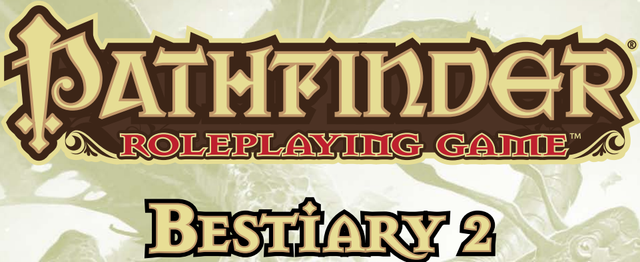
Pathfinder Bestiary 2: Badgers to Bunyip
Badgers
The badger (CR ½ Small Animal) – specifically implicated here to be the European badger Meles meles – is an animal from the Monster Manual/SRD of Dungeons and Dragons that was missed by Pathfinder Bestiary Prime, so it shows up here. There is also the dire badger (CR 2 Medium Animal), which is where we first learn that Pathfinder Bestiary 2 has abandoned its predecessor's attempt to shoehorn actual prehistoric animal species into the roles of dire animals. No fossil creature here, just a big, ornery man-sized badger with thick muscles and large claws. Gnomes respect and fear dire badgers because they are ferocious murder-beasts that can dig through solid rock.
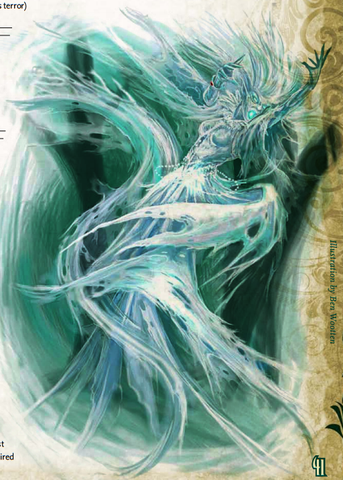
Banshee (CR 13 Medium Undead [Incorporeal])
The origin of the banshee is in Irish folklore, where she was a faerie or spirit that wailed to foretell the death of someone in the listener's family, most likely inspired by actual funerary wailing practices from the British Isles ("keening") given a mythological slant. This doesn't matter at all to the Pathfinder banshee at all, mind you. It instead traces its heritage back to the Dungeons and Dragons interpretation of the monster. Big surprise, I know. In its first, second, and fifth editions, the banshee of D&D has been presented as the undead soul of an evil and corrupt elf woman. Pathfinder very much takes this ball and runs with it. The banshee always elven and always female, and is also specifically either betrayed or was betrayed by people she loved rather than generically corrupt.
No keener for the dead, the banshee here is an active and malevolent force that seeks to slay the living, and she mainly does that through her wail. This wail has a forty foot radius, can be used once per minute as a full round action, and forces a DC 23 Fortitude save to avoid taking a flat 140 untyped damage (which is pretty much a save or die anyway for the levels you'd be fighting one). Her touch also inflicts 14d6 negative energy damage and induces a Will save to avoid spending 1d3 rounds just huddled up in fear.
Bats
Two more bats to add to the dire, familiar, and swarm sorts of the first Pathfinder Bestiary. The mobat (CR 3 Large Magical Beast) has been around since the 1E module The Lost Caverns of Tsojacanth, and for whatever reason it was in the Tome of Horrors and has thus come to rest here as well. They are omnivorous dire bats that technically have the same Intelligence score as an ogre but don't actually do anything with it, since the only things they do differently from other bats is that they like to prey on live warm-blooded prey (as opposed to other predatory bats that do exactly the same thing, so...huh?) and like shiny objects.
Skavelings (CR 5 Large Undead) are literally just mobats that have contracted ghoul fever and thus risen as undead with the paralytic bite and slightly greater Strength associated with human ghouls. They are even straight up called ghoul bats, which makes me wonder why D&D and Pathfinder never just straight up went a ghoul template from the start like d20 Modern did, since it would probably lessen the amount of ghoul bats, ghoul wolves, and ghoul god-knows-what-else you see in various bestiaries of both systems. Skavelings are intentionally created as mounts by the urdefhans, weird half ghoul half daemon Outsiders from way later in this book.
Bees
Giant bees (CR 1 Medium Vermin) and their queens (CR 5 Large Vermin) are more of the beasts and bugs from the 3E Monster Manual and subsequent System Reference Document that didn't make it into the first Pathfinder Bestiary and thus washed up here. Since they are giant honeybees, they go around pollinating giant flowers, defending their hives, and other things honeybees tend to do. They also have developed stingers that don't rip out and kill them after one sting like real bees, so they can and will repeatedly stab you with their venom-laden ass daggers if you anger them. Giant bumblebees get the Advanced Creature simple template slapped on them and deal Constitution damage rather than Strength damage with their stings.
There is also a note on royal jelly, the substance that is fed to a giant bee larva to induce its metamorphosis into a queen rather than a worker. There's 2d6 pounds of it deep in the hive, and eating a pound of it acts as a full day's nourishment, grants a +4 bonus to all saving throws against disease for a full day, and heals twice the amount of HP and ability damage you'd normally heal by sleeping if you sleep within that twenty four hour period. It can also be sound for a hundred gold per pound.
Beetles
Two more giant beetles, if you're of the sort that's into them. Giant stag beetles (CR 8 Huge Vermin) are elephant-sized stag beetles that are carnivorous instead of herbivorous like normal-sized stag beetles. Because everyone knows that herbivores can't be scary, right? It's not like there's an existing giant herbivore that is feared for its power and temperament, like, say, an elephant. Even AD&D had giant stag beetles as herbivores, specifically marking them as dangers to farmers due to their tempers and tendency to devour entire crop fields. Anyway, they're big, mean, and trample prey before eating them.
Its page counterpart is the slicer beetle (CR 4 Large Vermin), a remnant from the first edition Monster Manual II and the world of Greyhawk that came to Pathfinder through the Tome of Horrors. They're giant death watch beetles that have lost their wings and their eyes due to a life spent entirely underground, leaving this nasty flat-bodied critter with large jaws that do exactly what the name implies. These slicing jaws deal 1d6 bleed damage and stagger the foe for 1d3 rounds on a critical hit thanks to how immensely strong and painful the bite is. This is a merciful step down from AD&D and Tome of Horrors's "save or this beetle amputates a limb".
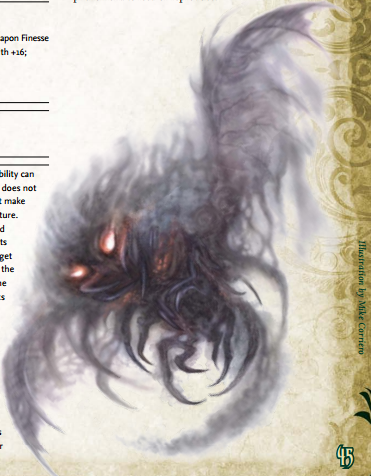
Belker (CR 6 Large Outsider [Air, Elemental, Evil])
Belkers are violent, smoky elementals from either the Para-elemental Plane of Smoke (if you're following AD&D's Planescape setting, where they first appeared) or the Elemental Plane of Air (according to 3E's Monster Manual). They were presented as reclusive and even sometimes conversational creatures that were nonetheless Neutral Evil due to the fact that they enjoyed causing pain to those they hunted. The belker of Pathfinder is a bit less nuanced, as it is entirely xenophobic and very unlikely to chat you up. Belkers hate all non-elemental life, as well as djinn and jann, and will stalk and kill all things they perceive as threats. In spite of appearing to be weird smoke demons, belkers are apparently fully solid, as they have a bite attack, two claw attacks, and two wing attacks. They can also transform into an incorporeal smoke form for up to twenty rounds, at which point they can force a DC 17 Fortitude save or be intentionally inhaled by a foe. Once it's inside a foe, the belker can deal 3d4 untyped damage per round, with the victim continuing to make a Fortitude save each round to attempt to finally cough the belker back up.
Blindheim (CR 2 Small Magical Beast)
Would you be surprised to learn that a humanoid frog with flashlight eyes was originally from the 1E Fiend Folio? I'd guess not. In the first two editions of the game, blindheims were sometimes of animal intellect and sometimes dumb but sapient, as well as color-coded in the manner of true dragons in that different skin colors of blindheim could produce different supernatural effects from their eyes. Neither of these things were retained in the Tome of Horrors, and it is thus that we have Pathfinder blindheims that are more or less the frogfolk equivalent of chimpanzees. They are clever but not sapient omnivores that feed mainly on fungi and small rodents in their cavern dwellings and sometimes hunt in packs. Their main method of both defense and offense is the ability to let loose a thirty foot beam of light from their eyes, forcing a DC 13 Fortitude save to avoid being blinded for an hour. Some races train blindheims to act as living light sources, and both drow and duergar are known to capture them and use them as distractions during raids.
Blink Dog (CR 2 Medium Magical Beast)
These fellows have been around since the classic Greyhawk supplement, so good for them on surviving this long. Over the editions, they have been described as looking like African wild dogs, dingos, and various domestic dogs of all stripes, but their two consistent features have been that they are either Lawful, Good, or both and that they are capable of "blinking" in and out of the physical world. Since they were in the 3E Monster Manual but not in Pathfinder Bestiary Uno, they get dumped here. Blink dogs here are slender hounds with rabbit-like ears, human intellect, and a Paladin mentality. They are loyal to a fault, especially to their pack's alpha, and spend their time traversing the land slaying evil beings. Their greatest foes are the similarly dimension-walking phase spiders. They also have a big culture of astrology, because why not.
Bodak (CR 8 Medium Undead [Extraplanar])
The bodak takes its name from the Gaelic bodach ("old man", or "old penis" if you translate it extremely literally), a rather horrible spirit or faerie that crawls down chimneys to steal away disobedient children and eat them. Besides the name, however, the bodak of D&D and Pathfinder has nothing to do with the Irish boogeyman. Instead, it is the result of a humanoid that has fallen in the most vile parts of the Abyss and become a charred grayish-black undead abomination as a result. It has been around since The Lost Caverns of Tsojcanth, and even appeared in d20 Modern's version of the Monster Manual as an undead Gray alien that has been warped beyond comprehension after being exposed to ultimate evil.
Bodaks in Pathfinder are still residents of the Abyss, though not necessarily created there, instead being the afterlife-dwelling result of any soul's warping by "a horrific, occult phenomenon". They are dim-witted beasts that only know their hatred and suffering, wishing nothing more than to inflict suffering on others. Some liches and powerful demons even use this to their advantage and have bodaks as henchmen for murderous purposes. While it can just punch you if it wants to, a bodak prefers to utilize its gaze attack. This gaze has a thirty foot range and forces a DC 18 Fortitude save to avoid 1d4 negative levels if that gaze is met; a humanoid that is killed by a bodak becomes another bodak after twenty-four hours. Luckily, like shadows and most other plague undead, bodaks suffer 3d6 damage per round if exposed to direct sunlight because of their "impure flesh".
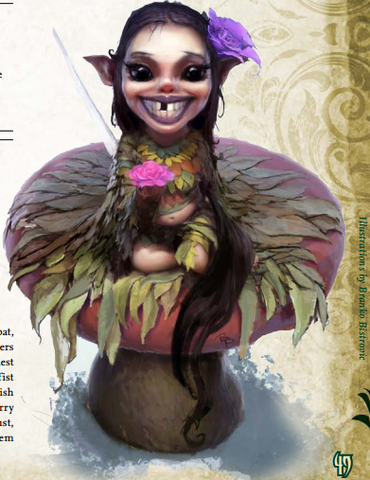
Brownie (CR 1 Tiny Fey)
Another creature that went the path of AD&D 1E and 2E to the Tome of Horrors and then Pathfinder. Like their mythological namesakes, brownies are helpful sorts, doing various chores and tasks in exchange for taking a bit of food. Unlike their namesakes, the brownies of D&D and Pathfinder usually live in the woods, only rarely shacking up in households like the Gaelic fair folk do. All brownies carry blades, but are extremely hesitant to actually use it, instead preferring to trick foes with spell-like abilities such as Dancing Lights, Lesser Confusion, Mirror Image, and Prestidigitation before using Dimension Door to whisk themselves away from danger. Also, for whatever reason, these books seem to love having brownies' art make them look like little shits. If you don't get that vibe from the Pathfinder Bestiary 2 image above, you'll probably at least get it from the art in the Tome of Horrors. I mean, look at this little fucker:
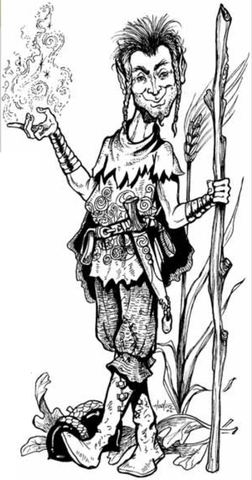
Bunyip (CR 3 Medium Magical Beast [Aquatic])
The bunyip is probably one of my favorite creatures from Australian aboriginal folklore. It's a big, mean, and loud aquatic monster that has any number of varying and conflicting appearances, just this beautiful encapsulation of the fear of the unknown into one ephemeral nightmare. And what form has the bunyip taken here? Out of all of its potential nightmarish visages, what one graces the pages of Pathfinder?
...A man-sized hybrid of shark and seal, just like it has was in the Fiend Folio and Tome of Horrors before it.

Bunyips are found in all major shallow waters, both freshwater and saltwater from the tropics to the poles. They are temperamental, especially in the mating season, and feed on all sorts of creatures Small size or smaller. While usually solitary, they come together to mate each spring, with the female giving birth to between four and six pups. A bunyip can go into a Barbarian-style rage if it smells blood, and its hundred-foot radius roar forces all creatures with 4 or less HD to make a DC 13 will save to avoid become panicked for 2d4 rounds.
Next time in the Pathfinder Bestiary: C is for centipede, cockroaches too. They crawl forth from shadows to mutilate you.
Carnivorous Blob to Crysmal
Original SA post
Pathfinder Bestiary: Carnivorous Blob to Crysmal
Carnivorous Blob (CR 13 Colossal Ooze)
An homage to a certain Cold War horror movie you might know of, the carnivorous blob is a giant red blob that rolls around and consumes any fleshy bits that happen to get in its way. Like the monster of the 1958 film, the carnivorous blob is vulnerable to the cold. Also like the monster of the 1958 film, "some sages" (the unnamed sages being a cliché from AD&D that also made its way into Pathfinder) believe that these oozes come to Golarion via meteorite. Being absorbed, constricted, or even just hit by the 8d6 damage pseudopod of a carnivorous blob also deals 1d4 Constitution drain, so good luck with that.
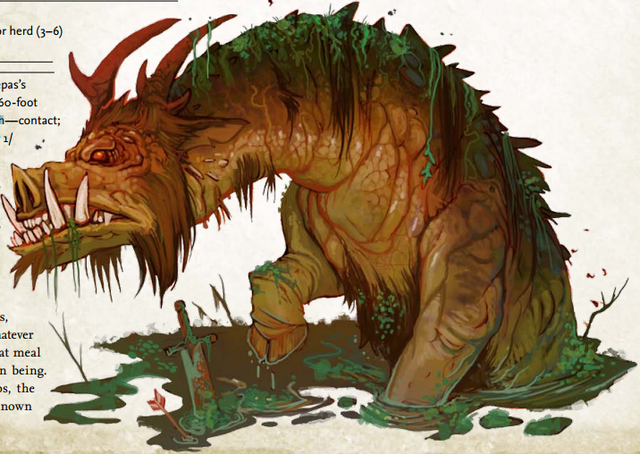
Catoblepas (CR 12 Large Magical Beast)
The catoblepas comes to us courtesy of Pliny the Elder, everyone's favorite weird Greek uncle with a thousand stories to tell. Said to be a native of mysterious Ethiopia, the catoblepas was an ugly bull-like beast with a head so heavy it could barely pick it up. Depending on which Greco-Roman philosopher you asked, the catoblepas could poison you, turn you to stone, or outright kill you with either its gaze or its rancid breath. It is believed that antelopes of the genus Connochaetes , known as wildebeests or gnu, are the origin of the legend of the catoblepas, since they don't have murder-breath but do resemble bovines and keep their large and heavy heads to the ground much of the time as they forage. Fortunately for players, Pathfinder has taken the poison breath route with their catoblepas; less fortunately, it's also given them some new non-mythological traits that make them nastier foes.
Not only are Pathfinder's catoblepas ravenous omnivores rather than herbivores, they are also sapient (5 Intelligence, so just below an ogre in IQ), actively enjoying bullying other creatures and even actively killing off large groups of small animals with their poison breath just so that other predators can't get anything to eat. A catoblepas will even pick a fight with something as big and nasty as a froghemoth or black dragon without any concern for the mismatch in power. The only thing you can do to keep one from picking a fight with you is to either run away or act in a submissive manner so that the catoblepas is assured you respect its authority.
Centipedes
With their numerous legs, slithering chitinous bodies, and large fangs laden with venom, it's understandable that some people have their phobia boxes checked pretty hard by centipedes. The two centipedes here are fleshed out versions of two of the "we only have room for this 1/2 HD man-sized centipede and a swarm, have some names with HD and size categories you can go stat up for yourself if you really want to" sidebar from the first Pathfinder Bestiary. The giant whiptail centipede (CR 3 Huge Vermin) is a giant carrion-eating centipede whose tails (actually modified legs if we're going to be pedantic about centipede biology, but whatever) deal nonlethal damage but also get instant trip attempts because they are long and whip-like, while the titan centipede (CR 9 Colossal Vermin) is a ridiculously massive predatory centipede that lives in the deepest jungles of the far corners of the map. Shame they're only CR 9, I could only imagine good things could come from having a titan centipede and one of the kaiju from Pathfinder Bestiary 4 getting into a fight if they were actually on even ground.
Chaos Beast (CR 7 Medium Outsider [Extraplanar])
Chaos beasts were horrific writhing Things That Should Not Be from the plane of Limbo in AD&D's Planescape setting, appearing in constantly shifting guises anywhere from monstrous oozes to grizzled birds of prey without rhyme or reason, memorable enough that they made their way into the Third Edition Monster Manual. Here, they are sort of a monster without a home, keeping the Extraplanar subtype but not assigned to any plane and given an illustration not unlike any other number of slimy PB1 creeps like the shoggoths or gibbering mouthers. Indeed, the entire entry of fluff concerning them is two sentences long – one noting constantly reforming shapes, and one on the fact that all their attacks count as claw attacks even if they sprout something that looks like a mouth/stinger/whatever.
Their trademark offensive move is still an infectious curse applied to their claw attack that, if the DC 17 Fortitude save against it is failed, deals a point of Wisdom drain per round and transforms the victim into a big goopy blob of shapeless sponge-like material. This removes any spellcasting or item use, reduces speed to 10 feet, and causes the victim to blindly attack anything near them, be it friend or foe. A DC 15 Will save allows the victim to keep their normal shape for a minute's time, but unless they shake off the disease with three consecutive successful Fortitude saves, their fate is ultimately to permanently become a spongeblob once their Wisdom score drains to 1.
Charda (CR 7 Small Monstrous Humanoid [Aquatic])
The chardas are a completely new race for Pathfinder, though not one intended for player consumption for a variety of reasons that will become clear soon enough. They are reptilian humanoids with thick crocodylian scutes, four arms with very large talons, and snake-like heads that live in extremely cold subterranean rivers and lakes. Charda tribes are reclusive, rarely straying from small territories around their huts of rock and mud built either underwater or just on the shore. Charda society is a vicious one, with infanticide and cannibalism being regular fare, Aklo (the Lovecraftian language of things like aboleths and Great Old Ones) as their native language, worship of war and cold-themed deities being a must, social status being determined by how effective at physical violence one is, and assistance in battle being seen as dishonorable to both charda and target, all of which makes it kind of surprising that they are marked as being a Chaotic Neutral race.
While the chardas have human intellects, they don't seem to have found any use for weaponry or tools, fighting with their bite and claw attacks. They also get an 8d6 cold damage breath weapon that can be modified to come out as either a sixty foot line or thirty foot cone.
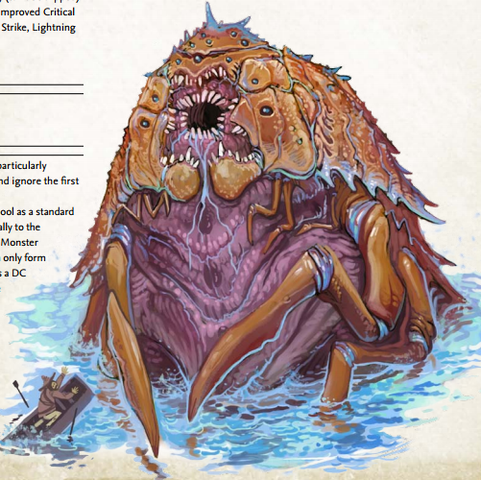
Charybdis (CR 13 Gargantuan Aberration [Aquatic])
60 feet (which should put it in size Colossal, but oh well) of mean, hungry, and slightly sapient isopod. As a bit of a wink and a nod to its Greek origins, the fluff states that sailors are so terrified of the charybdis that many of them believe that it is a singular beast created by an angry sea god, even though they are actually just simplistic ambush predators. Most charbdyis meals come in the form of sharks and whales, but they have learned that shipping channels happen to mean large groups of humanoids moving through on conveniently sinkable wooden ships, and thus often set up shop in straits and channels that are used for oceanic commerce. Since their bite and claw attacks only deal 2d8 and 2d6 damage respectively, charybdis mainly rely on their ability to create whirlpools to wear down ships.
...Wait, the whirlpool only deals 2d6 a round as well. Fuck.
Chupacabra (CR 3 Small Magical Beast)
The story of El Chupacabras, "the sucker of goats", goes back to the distant past of the 1990s, when Puerto Rico experienced a rash of sightings of a strange humanoid monster that looked vaguely like a Gray alien with digitigrade legs, spines down its back, and an arsenal of claws and teeth it used to supposedly exsanguinate local livestock. In the time since, the creature has been purportedly seen in other Latin and South American countries, and in the United States it has mutated into a hairless dog monster instead of a toothy Graylien for whatever reason. There's been a claim by professional skeptic Benjamin Radford that the entire Chupacabras flap originated with the 1995 horror movie species, which probably did indeed contribute but only as an augment of existing vampire lore and lingering Cold War-era conspiracy fears. But enough about that, on to the actual Pathfinder entry.
The chupacabra (sans the ending S as per popular American parlance) here is neither a monstrous extraterrestrial nor a mangy mutt, but instead a creature that looks like an anthropomorphic iguana with particularly long fangs. They are primarily solitary ambush predators that leap from rocky outcrops or tall grass to grapple prey and pierce their necks, draining them of blood. The chupacabra's blood drain has the secondary effect of granting it the effects of the Haste spell for ten rounds per successful siphoning. Particularly fertile hunting grounds sometimes lead to chupacabras hunting in packs, which are bold enough to actively attack whole farms or groups of traveling humanoids. Some random mutant chupacabras have wings on their backs and like to try to carry off goats and small children.
Cockroaches
Giant cockroaches (CR ½ Small Vermin) are dog-sized cockroaches that typically only attack with their weak mandibles if they are either scared or starving. Also mentioned are the CR 1 Medium giant hissing cockroach, CR 3 Large venomroach, CR 6 Huge spitting cockroach, CR 9 Gargantuan sawback cockroach, and CR 12 Colossal dragonroach, but like with the first Pathfinder Bestiary's giant vermin entries these are only given a name, size, total hit dice, and Challenge Rating with no information or stat block to give any more context for their sometimes strange names. There are also cockroach swarms (CR 2 Diminutive Vermin [Swarm]), which are swarms of vicious flesh-eating cockroaches that swarm over prey – usually rotting meat, but they are said to be willing to attack things as large as elephants – and rip it to shreds.
Crawling Hand (CR ½ Diminutive Undead)
Severed humanoid hands that have been animated by a necromancer to do any number of tasks, most of which involve raking with their claw-like fingernails or choking someone. They are based on the classic D&D monster known as the crawling claw, which Paizo apparently didn't know was Open Game Content via d20 Modern's Menace Manual since they didn't use them straight up. One thing crawling hands have that crawling claws don't, however, is the ability to cast Locate Creature on a specific individual once they are anointed with a drop of their blood. A variant of the crawling hand also presented here is the giant crawling hand (CR 5 medium Undead), which is the human-sized hand of some colossus that has become particularly rank. This advanced rotted status means that using a non-reach piercing or slashing melee weapon on it forces a DC 15 Reflex save to avoid a spewing blast of pus that causes 1d3 rounds of nausea and 2d6 negative energy damage.
Crypt Thing (CR 5 Medium Undead)
Is it possible to have a non-evil undead? Apparently not in Paizoland, as the formerly True Neutral crypt thing of 1E's Fiend Folio, 2E's Monstrous Manual, and 3E's Tome of Horrors has been realigned to be Neutral Evil. Exactly why is baffling, because the crypt thing still has the same role here as it did in earlier editions. It's a skeletal undead created specifically to protect burial sites from interlopers of any stripe. A crypt thing sits motionless and inert most of the time, refusing to interact with others even if they attempt to address it personally. If the area or burial object it is said to guard (or the crypt thing itself) is attacked or otherwise disturbed, though, it springs to life and creates a 50 foot radius burst of energy that teleports anyone that fails a DC 16 Will save 1d10x100 feet away from the guarded area/object. If the interlopers resist the teleport burst but still don't get the hint, the crypt thing begins slashing away with its clawed fingers.
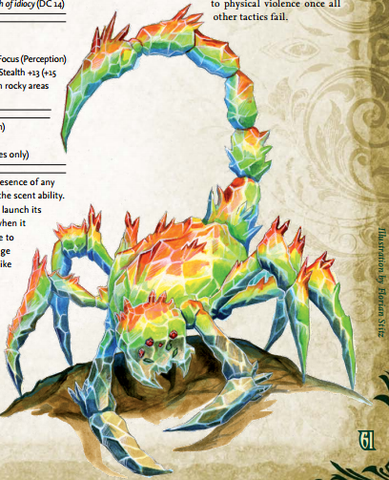
Crysmal (CR 3 Small Outsider [Earth, Elemental])
A psionic scorpion-shaped rock elemental that appeared in 1E'S Monster Manual II, 2E's Al-Qadim setting, and 3E's Psionics Handbook and SRD, the crysmal appears once again in Pathfinder Bestiary 2, albeit now with a bit of a facelift. Since the Pathfinder devs have an aversion to point-based psionics, the crysmal instead has become a casting creature that manifests spell-like abilities such as Detect Magic, Dimension Door, Mage Hand, and Touch of Idiocy. A crysmal can also launch its stinger as a projectile to deal 3d6 piercing damage to its immediate target and 1d4 piercing damage to all creatures in adjacent squares to said target. These are only defensive measures, however, as crysmals feed on gemstones and do very little else with their lives or their 6 Intelligence. If you say "hey, a gem-eating monster sounds like a way to be a shit about treasure," you're probably not wrong.
Next time in Pathfinder Bestiary 2: D is for daemons, dragons, and drakes. Many monsters of this letter, bringing death in their wakes.
Daemons to Dhampir
Original SA post
Pathfinder Bestiary 2: Daemons to Dhampir
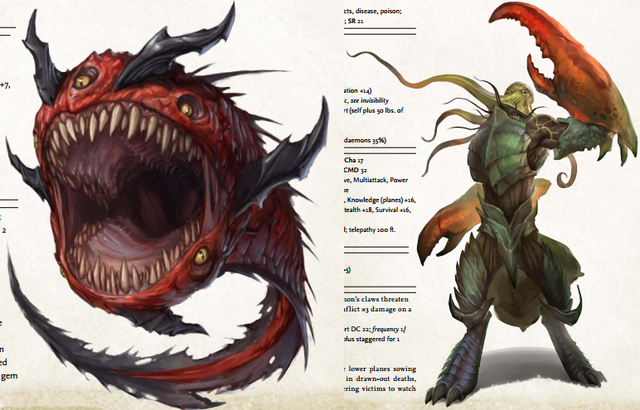
Daemons
In the lore of Dungeons and Dragons, daemons are the Neutral Evil mercenaries of the Blood War, selling their services to demons and devils in their ceaseless conflict of Chaotic Evil vs. Lawful Evil out of base greed. During the Satanic Panic, they were redubbed the yuugoloth, just as the devils and demons became the Baatezu and Tanar'ri respectively, but they retained their -loth titles in Third Edition in spite of the other two reverting back to their original titles.
Pathfinder's daemons are no longer mercenaries, but instead the ruthless forces of entropy that personify death through a specific manner. They seek only to bring death and ruin while hoarding mortal souls in their dread realm of Abaddon. The greatest of the daemons and their omnipresent leaders are the Four Horsemen of the Apocalypse. Having crawled their way up from humble daemons to god-like forces of destruction, the archdaemons Death, Famine, Pestilence, and War are said to eventually undo the multiverse itself before succumbing to oblivion in turn, bringing everything to nothingness. Legends also tell of the Oinodaemon, a fifth Horseman who is more powerful than even Death, but this is probably just an ancient superstition (spoilers: it's not, because the Oinodaemon/Oinoloth was in the Tome of Horrors, and you know what that means).
Astradaemon (CR 16 Large Outsider [Daemon, Evil, Extraplanar])
Our first daemon is also one of the ones new to Pathfinder. The astradaemon resembles a freakish mixture of deep sea fish and humanoid skeleton, and represents death by negative energy and level drain. While particularly strong, they're also pretty one note: they like souls, a lot, and kill mortals to eat more souls. Spells such as Enervation, Vampiric Touch, Energy Drain, and Finger of death are in its repertoire of spell-like abilities, and all three of their melee attacks (bite, two claws, and tail slap) come prepackaged with a forced DC 25 Fortitude save to avoid getting a negative level when you're struck. It also, of course, has a save or die attack with the same DC if it has a foe grappled. The sucked out soul from this attack grants the astradaemon a +1 profane bonus to attacks, saving throws, and all checks per five hit dice of the slain creature, the effects lasting for a day.
Cacodaemon (CR 2 Tiny Outsider [Daemon, Evil, Extraplanar)
Like other CR 2 Tiny Outsiders that have been in this book so far, the cacodaemon is meant specifically to be used as an Improved Familiar. The name cacodaemon was an ancient Greek term for evil spirits, and here it is represented by a toothy orb monster that totally isn't meant to evoke memories of something else with the same name. Cacodaemons sort of just pop up from the soul wells of Abaddon, not having any personification motif like greater daemons, and mindlessly float around looking for souls to eat. While the cacodaemon has no death magic of its own to get souls firsthand, it can swallow a soul of someone who has died within a minute's time and then puke it back up as a soul gem. Any Evil Outsider can eat a soul gem, which both grants fast healing 2 for a number of rounds equal to the Outsider's hit dice and damns the soul inside the gem to one of the lower planes. The cacodaemon's bite also leaks an easily resisted toxin that deals 1d2 Wisdom damage a day on a failed check.
Ceustodaemon CR 6 Large Outsider [Daemon, Evil, Extraplanar])
While the name may not strike you older D&D experts as familiar, I can assure you that this guy is one of the older edition's daemons and not a newcomer. You might know it better by its other name – guardian daemon. Guardian daemons, or yugoloth guardians, were a weird type of daemon/yugoloth that were Neutral with Evil tendencies rather than actually Neutral Evil, and were mainly summoned to defend something important. While the Tome of Horrors kept this distinction alive, in Pathfinder they have officially graduated to the Neutral Evil school of true daemonhood and received the moniker of ceustodaemon.
Ceustodaemons are horned ape daemons that represent a Neutral Evil creature's death by suicide (presumably because personifying death by suicide in all alignments might be perceived as offensive), and are known for being particularly weak to summoning and binding spells. It is for this reason that many spellcasters summon them for various tasks. Ceustodaemons are ultimately as nihilistic as any other daemon, however, and seek nothing more than to figure out a way out of their service in order to kill their subjugator. Their spell-like abilities include Dispel Magic, Fly, Hold Monster, and Slow, which they use as utility spells to augment their vicious claws and teeth.
Derghodaemon (CR 12 Large Outsider [Daemon, Evil, Extraplanar])
One of the daemons that has been around since 1E's Monster Manual II, the derghodaemon is an insectoid monster with three legs and five arms. In Pathfinder, its death motif is death through violent insanity, such as being killed by an insane murderer or a rabid beast. A derghodaemon's typical combat strategy is to cast either Creeping Doom, Insect Plague, or Summon Swarm and then attack with its rending claws in tandem with its summoned bug buddies, as the derghodaemon itself is immune to damage from swarms. It can also make a horrific grinding noise with its chitin that forces any creature that hears it within a 30 foot radius to make a DC 20 Will save or suffer from the Feeblemind spell for as long as the derghodaemon keeps up the noise and stays in range, which may be for a while given that it can do so as a free action.
Hydrodaemon (CR 8 Large Outsider [Aquatic, Daemon, Evil, Extraplanar])
Another old timer that appeared in the same book as the derghodaemon, the hydrodaemon is a frog-like monster that is stated to be easily mistaken for a boggard if it wasn't for their dead, white eyes. They represent death by drowning, and they unsurprisingly like to try to drown their prey as a result. If some good grappling under the water doesn't work, they also have spell-like abilities that include Acid Arrow, Deeper Darkness, Control Water, and summon spells for another hydrodaemon or a Large water elemental, as well as projectile spit that forces a struck target to make a DC 19 Will save or fall asleep for six rounds.
Leukodaemon (CR 9 Large Outsider [Daemon, Evil, Extraplanar])
Leukodaemons are the "deacons" Pestilences: not only do they service the horseman, they also embody the same form of death. They also resemble rotting satyrs with horse skulls and raven wings, so that's fun. Like their master, they wield a composite longbow that looses an eternal supply of arrows that force a struck foe to make a DC 19 Fortitude save to avoid being affected by the Contagion spell. They can also just cast Contagion at will as a spell-like ability, so the arrows seem a bit superfluous, but whatever. A leukodaemon that isn't in the mood for arrows or spells can belch out a cloud of black flies that deals 8d6 slashing damage upon immediate impact and then sticks around for 1d4+1 rounds, dealing 4d6 damage to anyone in the cloud and also forcing a Reflex save to avoid being sickened for a minute afterward. Anyone in a 50 foot radius of a leukodaemon suffers a -4 penalty to saves against disease as well.
Meladaemon (CR 11 Large Outsiders [Daemon, Evil, Extraplanar])
The jackal-headed meladaemons are Horseman Deacons like leukodaemons, but for Famine instead of Pestilence. A meladaemon's main arsenal is its spell-like abilities, which feature such classics as See Invisibility, Cause Fear, Deeper Darkness, Blight, Horrid Wilting, and Waves of Fatigue. Their claws also deal 1d6 nonlethal damage from hunger pangs on top of regular damage, and their bite is imbued with a supernatural wasting disease that deals 1d4 Constitution and Charisma damage per day on a failed save. Finally, meladaemons also have the ability Consumptive Aura, which radiates in a 20 foot radius and forces a DC 22 Fortitude save to avoid taking 1d6 nonlethal damage and becoming fatigued.
Olethrodaemon (CR 20 Gargantuan Outsider [Daemon, Evil, Extraplanar])
The mighty olethrodaemons are massive scaly orbs covered in horns and kept aloft by four elephantine legs, complimented by four arms ending in adamantine claws. They represent mass death through catastrophe, and aren't particularly subtle on that point. All olethrodaemons have only one aspiration in life, and that's to be the olethrodaemon that gets to eat the very last soul in the multiverse. On top of spell-like abilities such as Wall of Fire, Wall of Firce, Wall of Ice, Disintegrate, Wail of the Banshee, and Blasphemy, anyone swallowed by either of the olethrodaemon's two mouths takes 4d8 damage from the digestive grind plus 1d4 negative levels, and managing to cut through the resilient stomach wall (Armor Class 20 and 40 HP) still only has a 50% chance of actually getting you out instead of into one of its four other stomachs. As a final terrifying weapon in its arsenal, the olethrodaemon has a 3/day use breath weapon that blasts a shrieking pile of black soul-smoke in a 120 foot line or 60 foot cone, dealing 20d10 negative energy damage.
Extremely powerful olethrodaemons are known as paragons and get a special bonus ability based on whichever Horseman they happen to serve. Olethrodaemon paragons of Pestilence afflict the Contagion spell with any of their natural attacks, paragons of War can grant any special weapon property of +2 enhancement or less to their natural weapons as a free action, paragons of Famine have a version the meladaemon's consumptive aura that deals 6d6 nonlethal damage and exhaustion rather than 1d6 and fatigue, and paragons of Death deal a negative level on their natural attacks.
CR 10 Medium Outsider [Aquatic, Daemon, Evil, Extraplanar])
After several new daemons in a row, the squid-headed and lobster-clawed piscodaemon appears to give us the fourth and last daemon from the 1E Monster Manual II that made its way up to Pathfinder. Rather than getting into the whole symbolism business of most of their buddies' Pathfinder incarnations, piscodaemons retain their original D&D role as daemonic officers, leading armies hellbent on destruction. Piscodaemons' big ol' pincers deal an extra 1d6 bleed damage and triple rather than double damage on a critical hit, and their tentacles release a toxin that deals 1d2 Constitution damage and the staggered condition each round for 6 rounds. They deliberately target strong enemies with their toxin because they get a sense of joy by breaking the hardy.
Purrodaemon (CR 18 Large Outsider [Daemon, Evil, Extraplanar])
Vulture-headed deacons of War. Purrodaemons are noteworthy for two things: the fact that they actually plan out their violent attacks, and that they can stab weapons into their flesh to give them magical powers. After a weapon's been jammed inside the purrodaemon for at least a day, it can be imparted with an enhancement of +4 enhancement or less. While the purrodaemon can have up to a dozen weapons stuck in it at once, only one weapon can actually be enchanted at a time, which is by default a +2 wounding halberd. These daemons also seem to be fans of the classic JRPG element triangle, as their spell-like abilities include Chain Lightning, Cone of Cold, and Flame Strike.
Thanadaemon (CR 13 Medium Outsider [Daemon, Evil, Extraplanar])
Thanadaemons resemble horned humanoid skeletons and are the deacons of Charon, the Horseman of Death. In spite of their appearance, who their master is, and the fact that they are literally boatmen of the River Styx, they are not the Charonodaemons/maennoloths of D&D; this is especially odd, given that Charonodaemons are actually in the Tome of Horrors and Pathfinder rarely passes up an opportunity to mine that vein. Regardless of that, as noted, thanadaemons operate skiffs along the River Styx and the other various pus-filled waterways of Abaddon, and they can be bribed to use their Greater Teleport- and Plane Shift (only valid in the Astral, Ethereal, and Evil-aligned planes)-capable boats to take you somewhere if you have at least 300 gold worth of gems. The problem with accepting this service is that they are deceitful and will typically "renegotiate the terms" and ask for more wealth once they have gotten their passengers partway to their destination and into a place that is particularly dangerous.
In combat, thanadaemons have a gaze attack that induces fear for 1d6 rounds on a failed DC 21 Will save, energy drain at the same rate as the astradeamon on both their natural claw attacks and any melee weapon they wield, the ability to summon 1d4 hydrodaemons or another thanadaemon once per day, and spell-like abilities that include Animate Dead, Desecrate, and Enervation.
Dark Slayer (CR 3 Small Humanoid [Dark Folk])
Dark slayers are another of the "dark folk" like the Pathfinder Bestiary 1's dark creeper and dark stalker, but is completely new to Pathfinder rather than a Fiend Folio alumnus like the other two. Dark slayers basically look like dark stalkers shrunk down to dark creeper heights, and are subservient to their taller brethren. Dark stalkers don't really care what happens to their slayer minions and will happily sacrifice them if it means gaining the upper hand in the situation at hand, an attitude that unsurprisingly breeds contempt in the slayers, many of whom wish to overthrow their handlers and lead a tribe of their own. The only thing besides killing that these shadowy humanoids find joy in is the investigation of magic items, which are typically tinkered with and either used up or broken within a short period of time.
Dark slayers are masters at hindering enemies in combat, with +2d6 sneak attack, poison use, and an extra 1d6 damage with any melee touch spell or spell-like ability that deals HP damage being combined with spell-like abilities such as Bleed, Chill Touch, Daze Monster, Darkness, Death Knell, and Inflict Moderate Wounds. Killing a dark slayer causes it to explode into a 10 foot radius ball of light that deals 1d8 sonic damage and forces a DC 13 Fortitude save to avoid being deafened for 2d4 rounds.
Death Worm (CR 6 Large Magical Beast)
The death worm is yet another creature from the Tome of Horrors, but a special case in that it's one that was written exclusively for the ToH rather than a Third Edition conversion of an older D&D monster. It seems very likely that the death worm was based on the central Asian cryptid known as the Olghoi Khorkhoi ("intestine worm") or Mongolian Death Worm, an observation that Paizo Publishing seems to have also made given that the death worm is one of the entries in the cryptid themed "Ecology of..." book Mystery Monsters Revisited – both are desert-dwelling worms, both have venom, acid, and electricity in their arsenals, and both are...you know...called death worms. The big difference is that the death worm of D&D and Pathfinder is a whopper of a worm that reaches the length of an adult rhinoceros, while the Olghoi Khorkhoi is said to be a slightly more palatable length of a human arm.
The death worm is a legendary and elusive beast that most city slickers claim is just a tale told by drunkards and braggarts. The legend is quite real, however, and extremely adept at disappearing from sight as it stalks prey in the deserts and steppes it calls home. Death worms are powerhouses given their Challenge Rating, with powerful jaws and toxin-coated skin that both impart a poison that deals 1d2 Constitution damage per round for 6 rounds, two different breath weapons to provide 4d6 electricity or 8d6 acid damage, and corrosive blood that deals 3d6 acid damage to anything metal. And as if that wasn't enough, the text helpfully tells us that there are rumors of even larger death worms out there – rumors that were confirmed in Mystery Monsters Revealed via the Tyrannosaurus -sized death worm leviathan . We'll meet her if I ever figure out a good format and manner to review the [x] Monsters Revealed series for these threads.
Decapus (CR 4 Aberration)
The decapus first appeared in the 1981 module Palace of the Silver Princess, later going on to become a monster of AD&D's Mystara, 3E's Tome of Horrors, and now Pathfinder's second Bestiary as well. It is an octopus-like creature with an ugly humanoid face that is as intelligent as the average human, though it doesn't really use that intelligence for anything more than its natural role as an ambush predator. Decapodes sit hidden in the branches of trees, using their ability to cast Minor Image at will and mimic the sounds of any creature they have encountered before to create traps for prey. Once in range, the prey is grappled with the decapus's ten arms and either strangled to death or moved into range of its widely grinning mouth to bite. The favored prey of the decapus is humanoids, with gnomes in particular being extremely tasty. Why?

Demons
Kalavakus (CR 10 Medium Outsider [Chaotic, Demon, Evil, Extraplanar])
Big, muscular blue demons with lots of horns and spikes. They typically act as the guards of the harems of stronger demons or as slavers, and are indeed formed from the souls of slavers, so go out there and beat these weirdos up. It probably won't come as much of a surprise that on top of being really strong and having lots of natural attacks from their horns, jaws, and claws, kalavakus have spell-like abilities such as Command, Greater Command, Dominate Person, and Symbol of Persuasion. They can also perform "soul enslavement", which forces a DC 18 Will save to avoid suffering a -6 to all attack rolls and saving throws against the kalavakus that performed the act.
Omox (CR 12 Medium Outsider [Aquatic, Chaotic, Demon, Evil, Extraplanar])
Made from souls who either destroyed something beautiful or desecrated something pure, omoxes are stinky ooze demons that slither around being gross and attempting to drown people. Cultists of the slime lord Jubilex will summon omoxes to watch over "sacred filth pools".
Shemhazian (CR 16 Gargantuan Outsider [Chaotic, Demon, Evil, Extraplanar])
A weird gigantic hybrid of lizardfolk, bear, wolf, and praying mantis that is born from the soul of a torturer or vivisectionist. Their gaze paralyzes and their bite deals 2d4 Strength drain, but their ultimate goal is always to mutilate and then devour their prey above all else. As a fun but ultimately inconsequential fact, their name seems to be evoking that of the Jewish fallen angel Shemyaza/Shemhazai.
Vrolikai (CR 19 Large Outsider [Chaotic, Demon, Evil, Extraplanar])
Remember the nabasu demon? No? Well, it was a demon from the 1E Monster Manual II that made its way into the Tome of Horrors and Pathfinder Bestiary 1 whose whole gimmick was leveling up by turning people into ghouls. The vrolikai is more or less a nabasu that has gone Super Saiyan: they turn purplish black, gain two more arms, grow a scorpion-like tail that forces a DC 27 Will save to avoid taking 1d6 Charisma drain and becoming confused for 1d4 rounds, and get a quintent of fancy +1 daggers that deal negative levels on a successful strike if the victim fails a DC 27 Fortitude save. Like their normal forms, vrolikais have a gaze attack that inflicts negative levels, but unlike nabasu the victims don't turn into ghouls, instead becoming juju zombies. What are juju zombies? Well, that's literally the whole rest of the book away, so sit tight on that one.
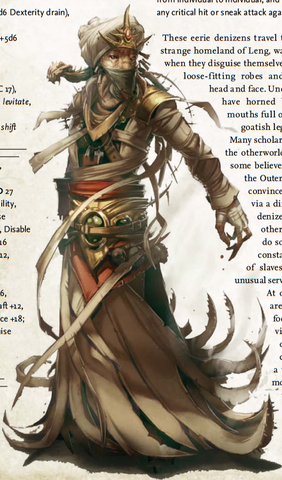
Denizen of Leng (CR 8 Medium Outsider [Chaotic, Evil, Extraplanar])
While H.P. Lovecraft may be most famous for Cthulhu and his pals, he also created many weird creatures that only existed in the Dreamlands. One group of such creatures were the men of Leng, primitive satyr-like beings that were slaves to the great moon beasts of Nyarlathotep and dwelt on the deadly Plateau of Leng. In Pathfinder, Leng is adapted as a chaos plane, and the men of Leng are recast as sophisticated but violent Chaotic Evil slavers rather than slaves themselves. Their flying ebony ships sail through the planes in search of new and interesting species to enslave and magical treasures to barter for, and they typically wear garb that covers most of their extremities in a totally convincing attempt to pretend to be human.
Denizens have a constant Tongues spell on, and are also capable of casting Detect Thoughts, Hypnotic Pattern, Levitate, Locate Object, Minor Image, and Plane Shift. If they want to hurt someone, their claws are sharp and their bite both deals damage and deals 1d6 Dexterity drain (lots of ability drain as opposed to ability damage in this bestiary, isn't there?). In turn, denizens of Leng are impossible to kill when they aren't on their home plane: they have fast healing 5 on any plane other than Leng, and if dropped to -10 HP they dissolve and then reform on Leng in 1d4 rounds.
Destrachan (CR 8 Large Aberration)
A confusing Neutral Evil eyeless dinosaur-thing that first appeared in the 3E Monster Manual. They kill with "destructive harmonics" (a breath weapon that can deal either 8d6 sonic damage or cause stunning for a round and deafening for 1d6 rounds), typically killing far more than they can actually eat simply because they are sadistic. The Pathfinder art for them gives them lamprey mouths, which is cool, I guess.
Devils
Accuser Devil/Zebub (CR 3 Small Outsider [Devil, Evil, Extraplanar, Law])
Zebubs look like the most emo tauric creatures, having the upper body of a fat baby and the lower body of a bloated carrion fly. They are created when devils torture a childlike innocent's soul into becoming a devilish creature. They act as spies or instigators that egg on petty sins into larger ones, but they're kind of dumb and typically get caught and slain in their own half-assed attempts to brew up intrigue. A zebub's bite inflicts a disease that deals 1d4 Strength damage daily as long as it remains in the victim's system, and its main supernatural ability is the power to act as a video camera for up to a day's worth of events that it can then "play back" in someone's mind at the rate of one hour per full round action.
Belier Devil/Bdellavritra (CR 16 Large Outsider [Devil, Evil, Extraplanar, Lawful])
A giant slug with three human heads on one end and a leech's head on the other. They can possess people to frame them for evil deeds.
Handmaden Devil/Gylou (CR 14 Medium Outsider [Devil, Evil, Extraplanar, Lawful])
Pathfinder Bestiary 2 posted:
Known as handmaiden devils, Mothers of Pain, and Maids of Miscarriage, gylous attend to the whims and schemes of Hell’s few female overlords. Like manipulative matrons amid decadent mortal courts, these deceivers hide their fathomless evil beneath illusions of beauty, graciousness, and tradition.
 " package is that they hate children and will literally stop everything that they're doing to go beat up babies if they hear one crying. Because childbirth is part of the natural female order, you see, and having no maternal instincts further shows this devil's corruption of the female ideal and...ah, fuck this stupid monster, let's move on.
" package is that they hate children and will literally stop everything that they're doing to go beat up babies if they hear one crying. Because childbirth is part of the natural female order, you see, and having no maternal instincts further shows this devil's corruption of the female ideal and...ah, fuck this stupid monster, let's move on.
Immolation Devil/Puragaus (CR 19 Large Outsider [Devil, Evil, Extraplanar, Lawful])
Immolation devils like fire a whole bunch. Who would have thought, right? Unlike other devils, they forego any sort of scheming and thought and instead head straight for the burning and killing, leading infernal armies as powerful generals. They can cast spell-like abilities such as Fireball and Fire Storm, and thanks to the special quality Hellfire any fire damage they do is instead parted into half fire damage and half unholy damage. All in all, these guys really feel more like demons than devils, and really bland demons to boot.
Devilfish
The devilfish is a sea beast resembling a giant version of the vampire squid ( Vampyroteuthis infernalis ) that haunts the depths of the great oceans. The thing that makes them special is that they have fiendish ancestry, which both makes them sapient and gives them a bottomless well of hatred. Think about how creative and flexible real octopi are, and then imagine they also fucking hate your guts and want nothing more than to see you die a horrible, agonizing death: that's the devilfish in a nutshell. Unfortunately, they didn't inherit any of their devilish forebearers' magic powers along with all that bad mojo, instead being forced to rely on their more mundane killing tools of seven tentacles, a beak laced with venom that deals 1d2 Strength damage per round for 6 rounds, and a nausea-inducing ink cloud.
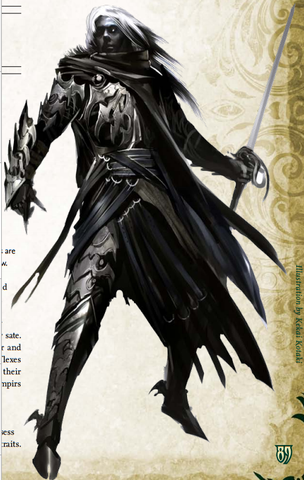
Dhampir (Medium Humanoid [Dhampir]; CR by class level)
In the folklore of the Balkan region of eastern Europe, vampire men are horny as hell and love to crawl out of the grave and try to have sex with mortal women. If this happens, the resulting pregnancy will end in either a stillborn child or a dhampir. Traditionally, the dhampir doesn't really have any vampiric powers or even supernaturally good physical traits; instead, the dhampir is rubbery (the vampire of south Slavic folklore is a gelatinous ooze until it has enough blood to reconstitute itself into a human shape), able to literally sniff out vampires, and can shoot a vampire with a gun and have it actually work. The dhampir seemingly inevitably becomes a vampire hunter and slays the kin of his father.
Now remove of all that from your head, because none of it has anything to do with the dhampir here. Pathfinder's dhampirs take their cues from the half-vampires of Blade, BloodRayne, and Castlevania rather than those of folklore. They are supernaturally beautiful and graceful, which makes people hate them because clearly the only supernaturally beautiful and graceful creatures in Pathfinder are vampires. In spite of the drow-looking guy in the art, dhampirs are actually stated to look like "statuesque humans of unearthly beauty" who are sometimes pale or bruised-looking. Mechanically, dhampirs are a playable race that gets +2 Dexterity and Charisma but -2 Constitution, low-light vision and 60 feet of darkvision, a +2 to Bluff and Perception checks, a +2 to saves against disease and mind-affecting effects, light sensitivity, immunity to the effects of level drain other than the "you can be killed by level drain" part, and the ability to cast Detect Undead three times per day. The Pathfinder Advanced Race Guide further expanded the dhampir with some more toys, including alternate racial abilities to provide fangs or animal kinship, feats for various levels of blood draining power, and a vampire hunter archetype for the Inquisitor class called the Kinslayer.
Next Time in Pathfinder Bestiary 2: D is for "D doesn't get another damn rhyme, I already did one". Dinosaurs, dragons, drakes, and also some things that don't have any scales on them at all are up in the second half of this long letter.
Dinosaurs to Elementals
Original SA post
Pathfinder Bestiary 2: Dinosaurs to Elementals
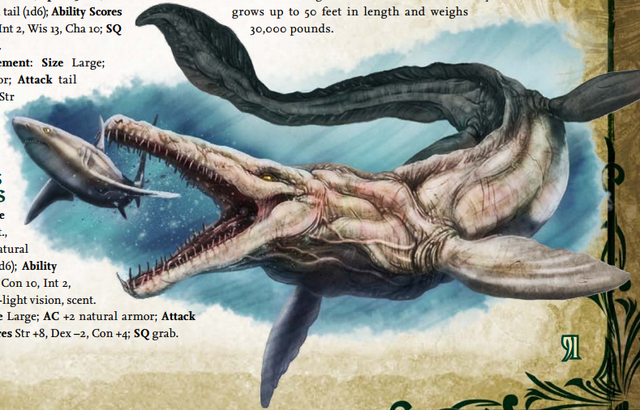
Dinosaurs
Allosaurus (CR 7 Huge Animal)
After its discovery in 1877, Allosaurus briefly had a period of being a really popular "big, nasty predator" in media before being ultimately eclipsed by Tyrannosaurus rex and acting as second fiddle in popular fiction where both species appear. This is a bit of a shame, as Allosaurus and its kin aren't really all that close to the tyrannosauroids and have interesting traits of their own such as extreme jaw articulation, but it is what it is. Comparing the two mechanically in Pathfinder, you are effectively exchanging the rex's ability to swallow prey whole and deal lots of critical damage for Big Al's slightly higher speed and a claw attack that is augmented by the Pounce and Rake special qualities.
Compsognathus (CR 1/2 Tiny Animal)
Compsognathus is well known in the public consciousness for two things: being the size of a chicken, and appearing in the movie version of Jurassic Park: the Lost World. The only two interesting notes here are that it has a venomous bite that deals 1d2 Strength damage per round and that it has a swim speed. The former is a Jurassic Park legacy, while the latter is possibly based on someone doing their research about the fact that Compsognathus lived in what was an island chain during the Late Jurassic. These tiny saurians can be taken as familiars, basically granting Improved Initiative to their master.
Parasaurolophus (CR 4 Huge Animal)
A large hadrosaur with a tube-like crest. You can take it as an animal companion, but it doesn't really have anything noteworthy about its stat block, and its flavor text is literally two sentences long and only notes its weight, length, and that it's known for its crest.
Tylosaurus (CR 8 Gargantuan Animal)
Not actually a dinosaur, but instead the largest of the mosasaurs, a group of marine lizards that branched off from the varanids (monitor lizards). The text informs us that Tylosaurus are known to attack ships that they mistake for whales, but they surprisingly don't get the Capsize special quality. What they do get is a land speed of 20, which means that they're going to be scooting along the dirt at the same speed as a halfling, something that actual mosasaurs almost certainly couldn't do.
Primal Dragons
"True dragon" is a term for the chromatic and metallic dragons, right? Wrong, it turns out that there are even more groups of true dragons out there, and one of these groups are the primal dragons. Primal dragons have most of the same things associated with the other groups of true dragons: sapience, spellcasting, age categories, all that jazz. Their main gimmick is that they are all extraplanar dragons with elemental subtypes that live on the elemental planes. All but two of them are some shade of Neutral as well.
Brine Dragon (CR 3 Tiny to CR 19 Gargantuan Dragon [Extraplanar, Water])
Lawful Neutral blue-green dragons with fish-like scales and fins that are native to the Elemental Plane of Water. Brine dragons aren't evil, but they're colossal assholes anyway, being selfish and power-hungry beasts that get depressed if they don't have a retinue of "lesser beings" to rule over. On top of an acid breath weapon, brine dragons are good at capsizing ships, have spell-like abilities that include Control Water and Horrid Wilting, their natural attacks shove salt and acid into wounds to force a Fortitude save to avoid being stunned for a round from pain, and the bite of an ancient or great wyrm brine dragon deals 1d2 or 1d4 Strength damage on top of their normal damage.
CR 5 Small to CR 21 Colossal Dragon [Air, Extraplanar])
The blueish-white cloud dragons of the Elemental Plane of Air are free spirits that roam across the boundless skies in search of new and interesting things to look at, talk to, or collect. Their breath weapon replicates the Fog Cloud spell rather than deals damage, and they can also innately replicate a special variant of the Gaseous Form spell that allows them to retain their normal fly speed. They also produce thunder when they bite, dealing an extra 2d6 sonic damage, and have spell-like abilities that include Cloudkill, Fog Cloud, Solid Fog, and Storm of Vengeance.
Crystal Dragon (CR 2 Tiny to CR 18 Gargantuan Dragon [Earth, Extraplanar])
These dragons are entirely made out of various colored gemstones, dwell deep in the Elemental Plane of Earth, and are our only Good primordial dragons. Unlike the stereotype of "stone = Law" you see with things like dwarves, though, crystal dragons are in fact Chaotic Good. They are obsessed with cleanliness for both their lairs and their crystal bodies, but at the same time are vain and quick to become violent when they perceive something as an insult to their
Magma Dragon (CR 4 Tiny to CR 20 Gargantuan Dragon [Extraplanar, Fire])
Big, ferocious Chaotic Neutral dragons with black scales that constantly leak lava. Their actions are seemingly inscrutable to outsiders, with acts of violence or peace being impossible to predict by anyone but other magma dragons. The magma dragon's breath weapon is fire, but at ancient age this gets boosted with an extra 1d3 rounds of the damage after the initial blast due to it being sticky lava. It gets upgraded again when the dragon reaches great wyrm age, as once per day it can vomit lava that deals normal breath weapon damage but also instantly cools, entrapping the victim for either 3d6 minutes or until they break free. Their spell-like abilities are a similarly conflagrational mixture that includes Scorching Ray, Delayed Blast Fireball, and Wall of Lava, and they tend to have at least one of their Sorcerer spell slots filled up with the Grease spell as insult to injury.
Umbral Dragon (CR 6 Small to CR 22 Colossal Dragon [Extraplanar])
While technically a primal dragon, the slimy, snaky Chaotic Evil umbral dragon comes the Plane of Shadows rather than any of the elemental planes. These merciless beasts eat ghosts and the undead, but will kill the living anyway because they are just that evil. Their breath weapon deals a special type of negative energy damage that acts normally against living targets but doesn't heal the undead, and their abilities are legion: immunity to energy drain and death magic, Ghost Touch on all their natural weapons at young or older age, a second 3/day breath weapon that forces a Fortitude save to avoid blindness for 1d4 rounds and 1d4 Strength drain for adult or older individuals, any kills it makes creating a shadow or greater shadow 1d4 rounds later in ancient or older individuals, 1 level of energy drain on bite or claw attacks at great wyrm age, and spell-like abilities that include Vampiric Touch, Shadow Walk, and Finger of Death.
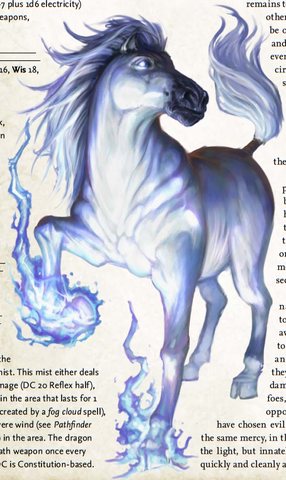
Dragon Horse (CR 9 Large Magical Beast [Air])
The long-man/lung-ma, or dragon horse, is a wondrous horse from Chinese mythology that has the scales of a dragon, can swiftly race across the sky, and is believed to be an omen of good fortune and leadership. When it appeared in the first edition of Advanced Dungeons and Dragons through the Monster Manual II, this was translated into the AD&D mindset by having the dragon horse be Goodly relatives of the kirin that are all for peace and happiness. In Pathfinder they lose the association with kirin, simply being weird sapient pacifist horse-things that freely travel between the Astral Plane, Material Plane, and Elemental Plane of Air. They try to avoid violence and even prefer to use nonlethal attacks on Evil mortals, though a creature with the Evil subtype gets the full brunt of their rarely seen violent side. The dragon horse's main weapon is a breath weapon that can shift to either replicate the Fog Cloud spell, whip up a severe wind, or deal 10d6 cold damage.
Giant Dragonfly (CR 4 Medium Vermin) and Nymph (CR 3 Small Vermin)
Giant dragonflies are found in and around swamps and marshes. Their dog-sized nymphs eat carrion and small animals of various stripes, while the adult forms specifically hunt warm-blooded prey. Boggards and other primitive swamp races often assign religious significance to specific colors of giant dragonfly.
Drakes
Referred to as "degenerate" versions of true dragons, drakes are vaguely pterosaur-like dragons with below-average Intelligence scores and none of the extreme powers and spellcasting that mark true dragons.
Flame Drake (CR 5 Large Dragon [Fire])
The drake version of red dragons, known for being extremely violent and ruthless. They travel in packs that attempt to bully humanoid settlements into giving them lots of tribute, engaging in raids against those who resist. Rather than a true breath weapon, flame drakes instead can belch out the equivalent of a Fireball spell every 1d6 rounds.
Forest Drake (CR 4 Large Dragon [Earth])
Atavistic green dragons. Forest drakes are more or less the same in attitude and action as flame drakes, to the point that some of their entry is just copy-pasted from the flame drake's flavor text. The only information new to forest drakes compared to the flame drake is that they love to eat elves and fey. Their vomit ball is an acid glob that deals 4d6 damage and replicates the Obscuring Mist spell on the impact site for 1d4 rounds.
Frost Drake (CR 7 Large Dragon [Cold])
Atavistic white dragons, though they are blue in color.
 Their entry is yet again a big copy-paste job with nothing really new, and their ball attack deals 7d6 cold damage and creates a 20 foot spread of slippery ice at the impact site.
Their entry is yet again a big copy-paste job with nothing really new, and their ball attack deals 7d6 cold damage and creates a 20 foot spread of slippery ice at the impact site.
Sea Drake (CR 6 Large Dragon [Aquatic])
Unlike the other drakes, the sea drake has no true dragon immediately connected to it, and it is described as being an inbred beast rather than a degenerate one. Did a true dragon fuck a sea serpent, and this was the result? Maybe, but nobody really knows. Sea drakes are solitary rather than pack hunters like other drakes, though they will band together to attack large prey or harass shipping lanes. The sea dragon's ball attack replicates the Chain Lightning spell.
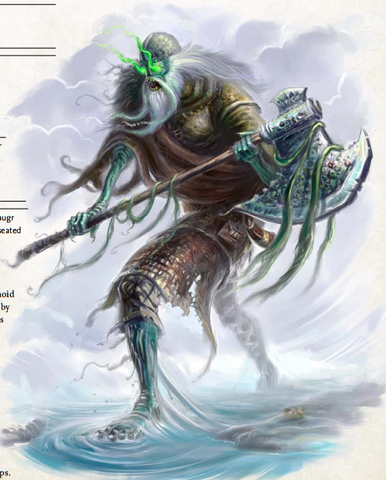
Draugr (CR 2 Medium Undead [Water])
The draugr is an undead monster of Norse mythology, a bloated corpse that was often (but not always) associated with the sea. You may recognize them as being a thing you saw very, very often in The Elder Scrolls: Skyrim. Here, they are pretty much what you'd expect, being angry Viking corpses that walk out of the sea to terrorize the living. They're big, beefy, and typically armed with large archaic weapons such as greataxes that nauseate those they deal damage to, but they aren't very bright. A variant, the red-eyed draugr captain, gets 3/day Obscuring Mist as a spell-like ability and deal a negative level when they deal melee damage. Draugr captains also often have levels in Barbarian, Fighter, or Rogue as an added incentive to worry about why one particular draugr in the encounter is described as having glowing red eyes.
Dullahan (CR 7 Medium Undead)
Traditional fairies aren't always nice, nor are they always pretty. Hell, they're frequently the opposite in both cases, which definitely applies to the terror that is the dullahan. It is a headless rider whose weapon of choice is a human spinal column, and when it comes riding into town death is sure to follow. Pathfinder's version is somewhat...less exciting. It's an undead from Hell, wields a +1 keen longsword that deals +1d6 cold damage, and can cast a special curse (DC 22 Fortitude save negates) that causes the victim to be staggered for 1d6 rounds, automatically suffer any critical hit for the next day, and automatically fail any Constitution check to stabilize while dying in the same time period. I can understand the change from Fey to Undead, but it seems like a huge lost opportunity to not have it flailing around someone's spine as a magic weapon instead of some dinky sword.
Dust Digger (CR 4 Large Aberration)
A monster from several AD&D modules themed around deserts and the Monster Manual II, the dust digger is a giant starfish with teeth that hides in the sand while waiting to ambush prey. Thanks to our good friend the Tome of Horrors, the dust digger appears unchanged in its description here, though the artist apparently didn't get the memo about it being a starfish-thing and instead drew it like the Sarlacc from Return of the Jedi.
As weird as a giant land starfish that acts like an antlion is, I wonder what it would be like if the Tome of Horrors had been stuffed to the gills with the really weird/dumb/hilarious AD&D monsters instead of the (admittedly sometimes still weird, dumb, and/or hilarious) ones it actually got. Imagine Pathfinder Bestiaries crawling with gello monsters, plush golems, saluqis, and stwinger faeries.
D'ziriak (CR 3 Medium Outsider [Extraplanar])
Weird termite people from the Plane of Shadow, d'ziriaks create massive cities consisting of hives decorated with various alchemical and magical decorations. Unlike many natives to their plane, d'ziriaks have no shadow-related supernatural abilities. In fact, they have just the opposite, with the power to erupt into a light show once per day that forces a DC 13 Fortitude save to avoid being dazzled for a minute. Their bodies are also coated in multicolored runes that constantly emit a dim light in a 20 foot radius around them. D'ziriaks are a True Neutral race that prefers to engage in trade with outsiders rather than fight, selling particularly strange wares such as light beams woven into physical artwork.
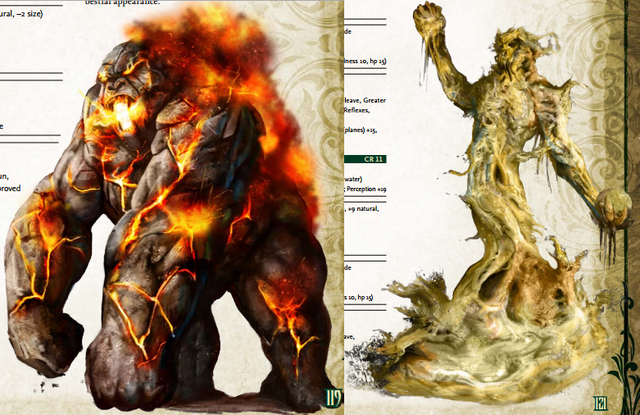
Elementals
Since there's only one entry in this letter, I figured I might as well shove it into the end of this post rather than have the next post cover even more letters than it already will.
Ice Elemental (CR 1 Small to CR 11 Huge Outsider [Air, Cold, Elemental, Extraplanar, Water])
Ice elementals are found where the Elemental Planes of Water and Air meet, a rather breathtakingly described place where "giant icebergs careen off of world-high waterfalls into the open sky". Unsurprisingly, the ice elemental's natural attacks deal cold damage, but they also have the interesting effect of forcing a Fortitude save to avoid being staggered for a round from just how bitingly cold their cold is. The ur-cold.
Lightning Elemental (CR 1 Small to CR 11 Huge Outsider [Air, Elemental, Extraplanar])
A vaguely humanoid storm cloud that constantly sparks with electrical discharge. They dwell within immense world-hurricanes that roll across the Elemental Plane of Air, and are known for being ridiculously violent: they are more than happy to die if they get a good fight in on their way out. If you are either wearing metal, wielding metal, or made of metal, the lightning elemental gets a +3 bonus to attack rolls and a +10 bonus to bull rush, disarm, overrun, and trip attacks against you.
Magma Elemental (CR 1 Small to CR 11 Huge Outsider [Earth, Elemental, Extraplanar, Fire])
Magma elementals live on the border of the Elemental Planes of Earth and Fire, and tend to take on beast-like forms. Their main claim to fame is that they can turn all the squares they occupy into lava terrain once per day.
Mud Elemental (CR 1 Small to CR 11 Huge Outsider [Earth, Elemental, Extraplanar, Water])
Natives to the meeting place of the Elemental Planes of Earth and Water. There's nothing really interesting about them to note.
Next Time in Pathfinder Bestiary 2: F, G, and H are all a bit small, so in the next post we'll just cover them all. F is for fetchling, G is for gar. And H is for hippo, the cruelest by far.
Faceless Stalker to Gug
Original SA post Pathfinder Bestiary 2: Faceless Stalker to Gug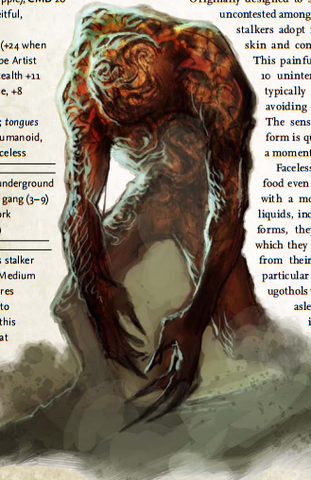
Faceless Stalker (CR 4 Medium Aberration [Shapechanger])
The faceless stalkers (or ugothol, as they call themselves) were created as servants of the aboleth empire. They were abandoned when the scheme they were created for failed, and left without a home or a purpose the stalkers decided that the best course of action was to mope in caves and drink people's blood while torturing them. Faceless stalkers can shapeshift into any size Medium creature of the Humanoid type, but this process takes ten minutes of uninterrupted changing, is painful to the faceless stalker, and only bestows cosmetic benefits.
Fetchling (Class Level-Dependent Medium Outsider [Native])
Fetchlings are former humans that were mutated by the energy of the Plane of Shadow, becoming monochrome other than their glowing yellow eyes. They like to stick their noses in interplanar political maneuvering and trade, but not much else is stated about them here, and even their entry in the Advanced Race Guide is more or less a longer version of discussing their love of politics and mercantile pursuits. Oh, and fetchling is kind of racist – they prefer to be called kayal, which is an Aklo word meaning "shadow people".
As a player race, fetchlings get +2 to Dexterity and Charisma but -2 to Wisdom, darkvision and low-light vision, a +2 to Knowledge (Planes) and Stealth skill checks, have a 50% miss chance against them in dim light rather than the usual 20%, and have a slowly growing pool of spell-like abilities that starts with Disguise Self 1/day and gets the addition of Shadow Walk at class level 9 and Plane Shift (Plane of Shadow or Material Plane only) at class level 13.
Giant Fly (CR 1 Medium Vermin) and Giant Maggot (CR 1/2 Medium Vermin)
Pathfinder Bestiary 2 posted:
Wholly monstrous, these disgusting creatures have been known to sometimes attack still-living foes, particularly when they are hungry or living creatures disturb their meals.
Forlarren (CR 2 Medium Fey)
Unlike many monsters of ye olde 1E Fiend Folio, the forlarren is a tortured soul that seems to come straight out of some "this ain't your daddy's roleplaying game!" fantasy heartbreaker. Specifically, they're a faun-like creature that is the result of a daemon raping a nymph. Forlarrens are so utterly misanthropic that they typically murder their own mothers before going on to lash out at anything and everything during their self-loathing lives. Rather oddly, in spite of changing them from True Neutral with Evil tendencies to full-on Neutral Evil, Pathfinder has given the forlarren a new special ability wherein she has to make a DC 15 Will save or become nauseated from pure remorse and grief for 1d6 rounds after killing a living being. The Pathfinder forlarren also has had her ability to cast Heat Metal as a spell-like ability boosted from 1/day to 3/day, and it can optionally be slotted out for another spell-like ability such as Chill Metal, Flame Blade, Flaming Sphere, Gust of Wind, Summon Swarm, or Warp Wood.
Also, while not really relevant textually, Pathfinder definitely did a lot better job of making forlarrens look part daemon than the Tome of Horrors did:
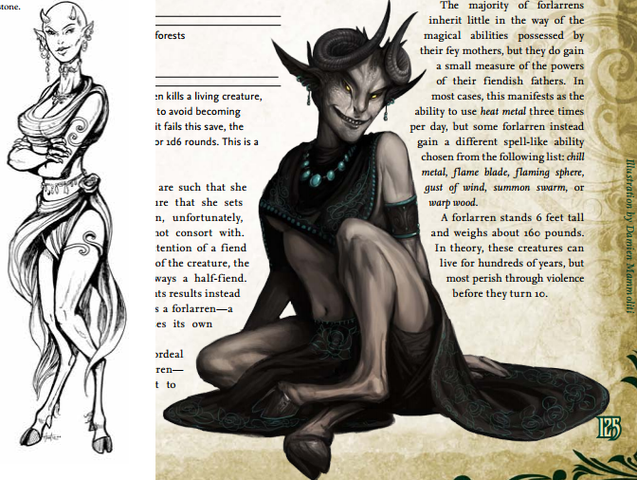
Frost Worm (Huge Magical Beast [Cold])
Giant worms that radiate intense cold, the frost worms of the far north fear no other monster besides the remorhaz, which is smart enough to have a fire breath weapon in a realm of creatures with the Cold subtype. A frost worm is capable of entrancing prey as well, thanks to a noise described alternately as either a trilling or a keening. This forces a DC 18 Will save to avoid being fascinated for as long as the worm keeps up concentration, presumably reflecting the subject being lost in thought about what the fuck a trill sounds like.
Fungal Crawler (CR 3 Small Aberration)
The fungal crawler is a subterranean giant cricket with sharp teeth and a coating of various symbiotic fungi. This symbiotic relationship grants them the immunities of the Plant creature type without any of its drawbacks, as well as the ability to subsist on ambient heat and radiation when fresh meat is scarce. It is possible to pseudo-domesticate and even train fungal crawlers as long as they are kept well fed, but they will turn on their "owners" as soon as the flesh stops flowing. It is stated that fungal crawlers are extremely adaptable and have variants with Fly speeds, Swim speeds, and even the Cold and Fire subtypes depending on what types of cavern they inhabit.
Gar (CR 1 Medium Animal [Aquatic]) and Giant Gar (CR 6 Huge Animal [Aquatic])
Gar are described here as ravenous predators willing to eat anything up to their own body size, which amuses me greatly as someone who has a great fascination for and adoration of the alligator gar, which very much does not eat things as large as it is. Giant gar are as long as school buses and are said to be able to eat a horse and rider in a single gulp (ignore the fact that they can't because of how the Swallow Whole special quality actually works), and are found in deep rivers and lakes of far-flung places. Merrows, scrags, and sea hags sometimes keep giant gar as pets.
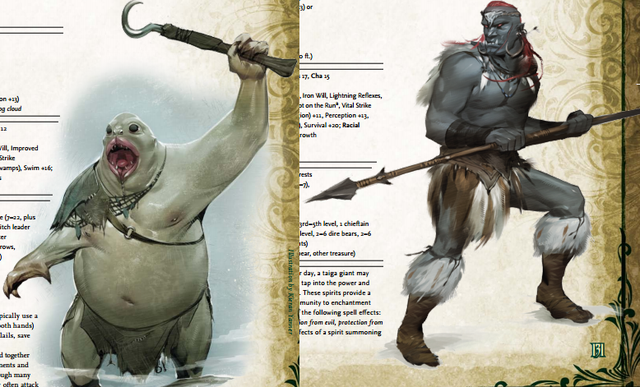
Giants
Marsh Giant (CR 8 Large Humanoid [Giant])
Savage and ever-hungry giants found in brackish water marshes and swamps. Their specific tastes dictate that a creature is tastier the more violent and hard to kill it is, and they aren't above killing and eating their own family members if they seem particularly tasty. While they already look very Innsmouth as it is, there are some marsh giants that actually do get down and dirty with deep ones and give birth to what are called brineborn. Brineborn marsh giants have the Advanced template and get Speak With Animals, Contagion, Confusion, and Quench as spell-like abilities.
Rune Giant (CR 17 Gargantuan Humanoid [Giant])
The charcoal-skinned and rune-covered rune giants are big on a level that few giants in D&D or Pathfinder manage to reach, standing a whopping 40 feet tall. The reason for this is that they were artificially created by some asshole wizards in the distant past to act as a task force of slavers and slave drivers to put all other giant races under the wizards' heels. While this plan didn't pan out, the rune giants still remain in distant corners of the map, and other giants speak of them only in fearful tones around the campfire at night. In combat, the merciless rune giants wield both conventional weapons and the magical arts, being capable of casting spell-like abilities such as Charm Person, Mass Charm Monster, Dominate Person, and Demand. These spell-like abilities have a +4 to their save DC when used against other giants, and any time they are used the runes on the giant's body flash brightly and force a DC 24 Fortitude save to avoid a round of blindness. A rune giant can also "overload" these runes once every 1d4 rounds to produce an eruption of sparks that act as a 30 foot cone breath weapon that deals 10d6 fire and 10d6 electricity damage.
Taiga Giant (CR 12 Huge Humanoid [Giant])
20 foot tall gray-skinned giants of the north, the taiga giants are tribal beings that feed on mammoths, whales, seals, and walruses. They are known to use almost every part of what they eat, with the bone, hide, and sinew all going to service the tribe in some manner. They are also deeply spiritual and worshipful of their ancestors, innately capable of communing with the ancestors once per day to cast either Bless, Endure Elements, Protection From Evil, Protection From Good, or See Invisibility. They are also totally not XXL Magical Native Americans. Totally. Ignore the fact that later supplements even give them language and naming conventions based on the Inuit.
Wood Giant (CR 6 Large Humanoid [Giant])
Like ents, only looking like blown up elves instead of tree people. While they first appeared in 1990's Monstrous Compendium 5 and are thus a legacy monster, I recall even one of Pathfinder's designers not caring at all about the wood giants, which greatly amuses me.
Gloomwing (CR 4 Large Outsider [Extraplanar])
Coming from the 1E Monster Manual II, the gloomwing is a giant purple moth creature from the Plane of Shadow. It is the adult form of the tenebrous worm, a horrific murder-caterpillar that is actually more dangerous than its parent. The gloomwing acts much like the real world parasitic wasp, attacking out of a need to procure a safe home for its offspring rather than for a meal. To do so, it has a proboscis that deals as much damage as a greatsword, hypnotic wing patterns that force a DC 14 Will save to avoid being confused for a round if you look into them, and pheromones that force a DC 14 Fortitude save to avoid suffering -4 to Strength for the duration of the battle with this belligerent butterfly. A helpless or slain foe of size Small or larger can be implanted with 1d4 tenebrous worm eggs that hatch a day later; funnily enough, this was actually a fate only corpses suffered before Pathfinder. Go figure.
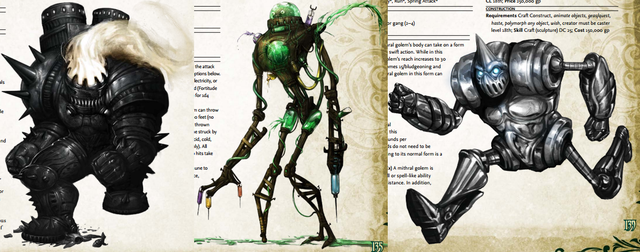
Golems
Adamantine Golem (CR 19 Huge Construct)
Big, bad, and
 as all hell: a good description of the aesthetic you see when you face off against an adamantine golem. Your estus flasks and learning through repetition won't help you here, though. This monstrous metal titan deals 6d10 sunder damage to your armor on any critical hit, has 15 damage reduction that is only bypassed by epic damage, gets fast healing 10, and
literally cannot be killed unless you either decapitate it with adamantine vorpal weapon or Miracle/Wish it away. Luckily for most people, the only person who can even create an adamantine golem is a level 20 Wizard who has to travel to the Elemental Plane of Earth to get two whole tons of pure adamantine, mithral, platinum, and gold. As with all golems, it has a bypass for its immunity to magic; in its case, Transmute Metal to Wood slows the adamantine golem for 1d4 rounds and allows adamantine damage rather than epic damage to bypass its damage reduction.
as all hell: a good description of the aesthetic you see when you face off against an adamantine golem. Your estus flasks and learning through repetition won't help you here, though. This monstrous metal titan deals 6d10 sunder damage to your armor on any critical hit, has 15 damage reduction that is only bypassed by epic damage, gets fast healing 10, and
literally cannot be killed unless you either decapitate it with adamantine vorpal weapon or Miracle/Wish it away. Luckily for most people, the only person who can even create an adamantine golem is a level 20 Wizard who has to travel to the Elemental Plane of Earth to get two whole tons of pure adamantine, mithral, platinum, and gold. As with all golems, it has a bypass for its immunity to magic; in its case, Transmute Metal to Wood slows the adamantine golem for 1d4 rounds and allows adamantine damage rather than epic damage to bypass its damage reduction.
Alchemical Golem (CR 9 Large Construct)
A golem animated by elementals trapped in a formula of various alchemical formulae, with a lifeless brain in a jar plopped on for fun. Its slam attacks (with needles?) deal both their actual 2d8 bludgeoning damage plus a random effect of 1d6 points of either acid, cold, electricity, or fire damage, sickening for 1d4 rounds, or entanglement for 1d4 rounds. It can also deal a point of one of those energy types with any melee weapon it somehow wields, or lob a 60 foot range alchemical bomb that deals 8d6 direct damage of one of those energy types plus 1d6 splash damage. The Shatter spell bypasses the alchemical golem's magic immunity to deal damage as if it was a crystal creature.
Carrion Golem (CR 4 Medium Construct)
A smaller and grossly rotted version of the flesh golem. It stinks so bad that it has an upgrade of the Stench special quality that imparts nausea rather than sickness, and its slam attacks impart a specific disease selected by the golem's creator. A load of spells bypass the carrion golem's immunity to magic: Gentle Repose paralyzes them into helplessness for 1d4 rounds, Animate Dead makes its body parts rebel against each other and deal 1d6 damage per caster level, cold or fire damage spells impart Slow for 2d6 rounds, and electricity damage spells grant Haste for 2d6 rounds.
Clockwork Golem (CR 12 Large Construct)
While the artwork makes it look like something the dwemer of the Elder Scrolls universe would make, this golem is actually a humanoid-shaped pile of hundreds of gears underneath its nice amber metal shell. The golem can use its gears either offensively to deal an extra 2d10 slashing damage during a grapple or defensively as it transforms itself into a 10 x 10 or 5 x 20 foot wall, exchanging the ability to move for the ability to deal 15d6 slashing damage to anything passing through its occupied spaces. It takes a standard action to transform into the wall and a move action to transform back. Even a dead clockwork golem can still grind its gears on your face, though, as it explodes into a 10 foot burst of 12d6 piercing damage shards. Finally, for magic immunity bypasses, Rusting Grasp staggers it for 1d6 rounds and deals damage normally and Grease produces Haste for 1d6 rounds.
Glass Golem (CR 8 Large Construct)
Glass golems are typically found being created in desert regions, where the sand needed to create the glass they are hewn from is prevalent. On top of dealing an extra 1d8 bleed damage with its natural attacks, a glass golem can cast Spell Turning on itself for a round every 1d4 rounds, and if it is in bright light any onlooker needs to make a DC 16 Fortitude save to avoid being dazzled for a round. The exceptions to magic immunity for this patricular golem are that Shatter damages it, Keen Edge works on its natural attacks, cold damage spells Slow it for 3 rounds, and fire damage spells heal it for 1 HP per 3 HP of damage the attack would have dealt. There's a variant called the stained glass golem that gains a +10 to Stealth checks but is otherwise unchained, because everyone knows that stained glass is far more hard to pin down than translucent glass.
Mithral Golem (CR 16 Huge Construct)
As its name implies, the mithral golem is made entirely of the silvery metal mithril. Its entire gimmick is "gotta go fast": on top of having a move speed of 50 feet and a Dexterity score of 24 (which is colossal by golem standards), it's got all the big name mobility feats like Run and Spring Attack as bonus feats, gets one more move action per round than any other creature normally gets, and can become liquid for up to 10 rounds per day to flow through any crack or hole of any size. On the magic front, Slow spells remove its extra move action for 1d6 rounds, Haste heals 1d6 damage per caster level (to a max of 10d6 per cast), and any cold damage spell cast on a mithral golem while it's in liquid form deals 10d6 damage.
Gray Render (CR 8 Large Magical Beast)
One of those other monsters introduced in Third Edition Monster Manual that didn't get into the first Pathfinder Bestiary, and thus ended up here. Gray renders in D&D and Pathfinder are pretty much the same thematically, being weird gray ape-things that "adopt" a creature or group of creatures as their own charges. Gray renders eventually get tired of their current entourage and move to find new unsuspecting groups to claim as their own pets, but until then they actively give food to their adopted entities and defend them to the death. Mechanically, it's just a really strong monster with nothing all that noteworthy.
Gremlins
Just as Outsiders have their various clans such as demons, devils, daemons, demodands, and other things that don't start with D, so too do other creature types. The gremlins are one clan of fey that are unified by being small, preferring the Material Plane over the realm of the fey, and loving subterfuge, destruction, and mayhem. The mite from the first Pathfinder Bestiary is retconned to be the lowliest of the gremlins, having lost their love for chaos and entered a state of self-loathing. As a result, other gremlins hate them and will engage in extreme violence towards them. Mechanically, on top of all being fey, all gremlins have at-will Prestidigitation as a spell-like ability.
Jinkin (CR 1 Tiny Fey)
Jinkins are gremlins that look more or less like the sort seen in the famous 1984 movie, and are just as ill-tempered and destructive. They love attacking larger creatures by stealing items from them, pretending to retreat, and then leading the target right into a sneak attack or set of deadly traps. If six jinkins get together, they can take an hour to cast Bestow Curse on a willing or helpless target or curse a magic item. Dwarves find jinkins particularly loathsome, which isn't all that surprising given that dwarven crafts and magic items are a big deal.
Nuglub (CR 2 Small Fey)
Extremely violent gremlins with hunched backs, a coat of oily black fur, and three glowing blue eyes. Nuglubs find great amusement in murdering helpless victims in the dead of night and then watching as people descend on each other in paranoia as they try to find the culprit. These crimes are typically conducted either alone or with smaller and weaker species of gremlin, as multiple nuglubs in one place will inevitably fight for dominance and eventually cannibalize one another. Nuglubs get a trio of spell-like abilities that they can use once per hour rather than the usual x/day formula, as well, with Heat Metal, Shocking Grasp, and Snare.
Pugwampi (CR ½ Tiny Fey)
Pugwampis look like tiny gnolls that were based on chihuahas instead of hyenas, and are probably the only monster in Pathfinder's history to be stated to have a canonical love of poop jokes:
Pathfinder Bestiary 2 posted:
Pugwampis live in caves or ruined buildings, occasionally venturing forth to find victims upon which to inflict their sick senses of humor. Their “jokes” tend to involve spikes and excrement, or sometimes pits full of spiders or campsites that flood with swamp water. Certainly only the pugwampis consider their jokes funny.
Vexgit (CR 1 Tiny Fey)
These insectoid gremlins are the ones that adhere most tightly to the traditional WWII-era conceptualization of what a gremlin is. They absolutely love to tear at and tinker with mechanical objects until they either stop working or become deadly hazards for humanoids to deal with. On top of being able to cast Rusting Grasp and Snare at a 1/hour rate, they have special abilities that allow them to treat objects as if they were one category simpler for the purposes of how long a Disable Device skill use takes and the granting of a +10 bonus to Disable Device checks when six vexgits gather to perform one task.
Grick (CR 3 Medium Aberration)
Another 3E-introduced monster like the gray render, the grick is a giant, slimy worm with a quartet of razor-sharp tentacles around a beaky mouth. Other than their freaky appearance, they're aren't that complicated, being another in the litany of large physical combat-based ambush predators you find in any given cave in D&D/Pathfinder-land. Pathfinder has a new variant of the creature called the jungle grick as well, which gains the Advanced Creature template and heads for the trees, dropping down from tree branches or attacking from the undergrowth rather than hiding somewhere in a cave.
Grig (CR 1 Tiny Fey)
Gaining their name from an older English word for both crickets and a type of apple-loving fairy, the grigs of Dungeons and Dragons just combined both definitions of the word by having them be tauric fey with the upper parts of pixies and the lower parts of crickets or grasshoppers. They've been around since the 1E Monster Manual II, reappearing again and again through the AD&D 2E Monstrous Manual, 3E Monster Manual, and eventually right here in the PB2. While D&D's grigs were harassing little shits that loved to torment humanoids, Pathfinder has envisioned them as gallant little paladins that are more than willing to fight evil far beyond their size, with a love of the arts on the side. Of course, the fact that their quest to fight evil is also stated to be one to "vanquish ugliness" makes them sound horribly superficial, which is...I guess pretty faerie-like, actually. Grigs can rub their legs together as a standard action to create a sound that forces a DC 12 Will save on any creature in a 20 foot radius that hears it; since Otto's Irresistible Dance isn't Open Game Content, failure here means that the foe is staggered for as long as the grig keeps concentrating to keep up the effect.
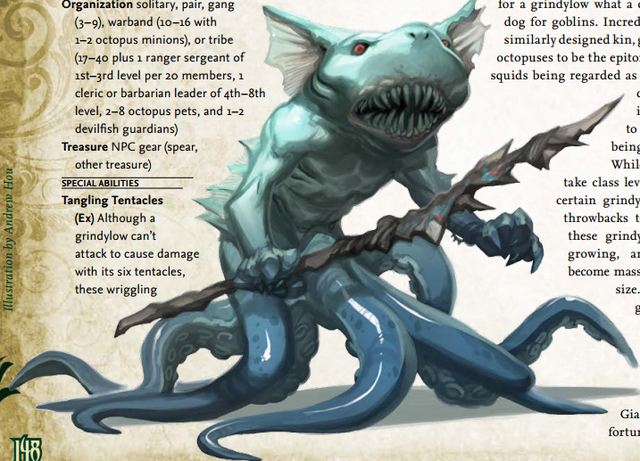
Grindylow (CR ½ Small Aberration [Aquatic])
In British folklore, the grindylow is a nasty water spirit or fairy that uses its long arms to grasp at children near the edge of their watery lairs, pulling them in to drown and eat them. Charming, those Brits. Anyway, while that's the origin of the name, Pathfinder's grindylows seem pretty clearly based on the ones seen in the movie adaptation of the fourth Harry Potter book on an aesthetic level, looking too similar for me to call it mere coincidence. Like pretty much every Chaotic Evil race ever, grindylows love violence and suffering, harming beings above and below the waves as a favored pastime, even ganging up to attack groups as large as merfolk clans and ship crews. They also have an almost religious reverence for the octopus and an equally great hatred for the squid, seeing the latter as a twisted mockery of the former, and will go out of their way to kill and mutilate any squid they find. A grindylow's tentacles don't actually deal any damage like those of a proper octopus, instead allowing for a special trip attack as a swift action that gains a +4 bonus and can't be countered on a failure.
Grippli (Class Level-Dependent Small Humanoid [Grippli])
A race of amphibian humanoids from the not so successful Advanced Dungeons and Dragons Monster Cards series of 1982, the grippli were effectively created as the Good frog people to contrast the Evil frog people that were the bullywugs. They were rather elf-like not only in their tree-living primitivism, but also in the fact that they combined a ridiculously long lifespan (700 years) with a tremendously low birthrate (around six or so tadpoles in that span). In Pathfinder, they are rather simplistically described, with just two paragraphs here and a paragraph in the Advanced Race Guide that is literally just the same information from this title regurgitated in a slightly different phrasing. Namely, they live in trees in rainforests or swamps, are omnivorous consumers of both giant insects and fruits, live about 60 years, and love metal and gemstone objects from the outside world. As a playable race, they get +2 to Dexterity and Wisdom but -2 to Strength and have a climb speed of 20 feet on top of their 30 feet land speed, darkvision, a +4 bonus to Stealth in marshes or forests, and move at normal speed in inclement swamp or marsh terrain.
Gryph (CR 1 Small Magical Beast)
A four- to eight-legged cave-dwelling heron that injects its eggs into live prey's bloodstream? Must be from the Fiend Folio. While I doubt that many people were exclaiming "bring back the gryph!", it was OGC-ized by the Tome of Horrors, so it ends up here anyway. While the gryph of yore's eggs hatched days after their traumatic insertion, the one here in Pathfinder implants 1d4 eggs on a successful sting attack that hatch in 1d4 minutes. The ravenous chicks deal 2 Constitution damage per chick as they violently erupt from the unwilling incubator's body and fly away. Managing a DC 20 Heal check or casting a Remove Disease or Heal spell before the gryph eggs hatch stops the process. At that point you're pretty safe, as the implantation is a 1/day ability and gryphs aren't actually all that interested in long-term combat.
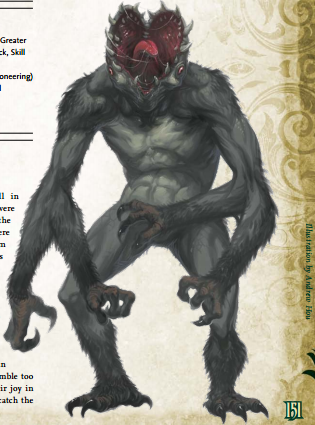
Gug (CR 10 Large Aberration)
Like the denizens of Leng from earlier, the monstrous gugs are taken from Lovecraft's Dreamlands. They're Chaotic Evil, so you probably already get their general MO: they maim people, torture them, sacrifice them to dark gods, yada yada. They'll eat their sacrifices as well, though they also consume fungi, slime, carrion, and undead creatures. In spite of the text's claim that gugs can contort themselves to gain longer reach or move through "impossibly small passages",
Next Time in Pathfinder Bestiary 2: Turns out that the bookmarks in the PDF version are broken, so this entry has less letters than what I'd last spoken. Next time is is H through K, but that's a story for another day.
Hangman Tree to Krenshar
Original SA post
Pathfinder Bestiary 2: Hangman Tree to Krenshar
Hangman Tree (CR 7 Huge Plant)
What evil lurks in the hearts of plants? A lot, apparently, as this sapient willow tree is Neutral Evil and lives to kill. It utilizes its vines as nooses to wrap and strangle its prey. It can also release spores that cause those who fail a Will save to begin hallucinating and believe that the hangman tree is actually just inanimate and totally not moving its vines up to their neck. I'm not sure why it needs to be almost as smart as an orc to do this, or is Neutral Evil for doing a thing that carnivorous plants already do on a small scale, but oh well.

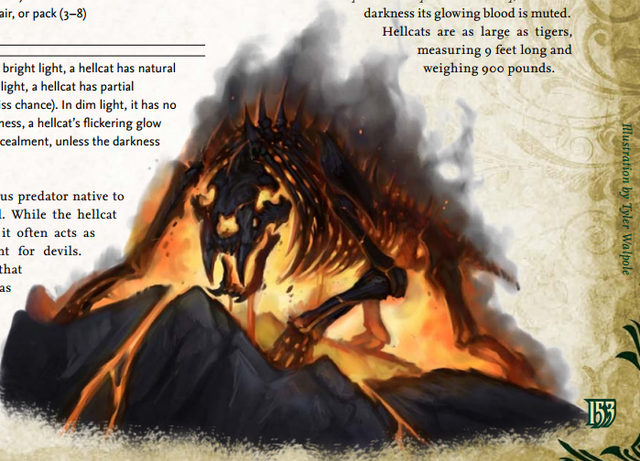
Hellcat (CR 7 Large Outsider [Evil, Extraplanar, Lawful])
Looking like an escapee from a metal album cover, hellcats are technically not devils, but it probably doesn't matter much when they have the same creature type, subtypes, and alignment. They are solitary hunters on the volcanic plains of Hell, killing for fun since Outsiders technically don't need to eat. The most important thing to remember about hellcats is the fact that they have human level Intelligence scores. They demand respect from others and will plan long and exacting revenge plots if they don't receive it, and both devils and mortal summoners alike get put on their shit list if they treat the hellcat like it is a mere animal. The hellcat's glowing red blood is a two-edged sword, becoming nearly invisible in bright light but making it unable to use darkness to its advantage.
Herd Animals
Real world herbivorous mammals that dwell in herds. Pathfinder Bestiary the first had bison and aurochs, so big bovine favoritism there. Here, instead, we have a caprine and a camelid. The camel (CR 1 Large Animal) reflects the dromedary camel, while the ram (CR 1 Medium Animal) is the American bighorn sheep. The camel gets a projectile spit attack that forces a DC 13 Fortitude save to avoid 1d4 rounds of sickness and teh ram gets a charge attack that boosts their gore damage from 1d4 to 1d8. Neither really has anything else to really note.
Hippocampus (CR 1 Large Magical Beats [Aquatic])
Horses, but underwater. How majestic. Their presence in mythology as the chariot-pullers of sea gods or use in Medieval heraldry isn't really touched here, and instead they're just horses but for merfolk and nothing more.
Hippogriff (CR 2 Large Magical Beast)
While Harry Potter may have made them famous to a wider audience, hippogriffs have been around since the Classical era. The traditional meaning of the hippogriff in its earliest forms is lost to time, buy for Roman philosophers and Medieval thinkers it was either a representation of the nature of impossibility, the conquering power of love, or something in between. For Pathfinder's part, their hippogriff is an absurdist creature literally made by a wizard who thought it would be funny to blend griffon and horse together because they are natural enemies. They are territorial loners that fiercely protect their domains from each other while also being forced to contend with wyverns, griffons, and dragons, which all consider the hippogriff tasty prey. Hippogriff in turn prey on mammals such as coyotes and deer, but also require grass to help aid in digestion of their prey. And where can you find mammals of that size and grass together in abundance? Farms, of course, which is why livestock ranchers are swift to put bounties on hippogriffs when they move into more humanoid-heavy areas.
For those who want to own a hippogriff alive rather than as a stuffed trophy, they are easier to train than griffons and fiercely loyal if taught right, being treated as Animals rather than Magical Beasts for the purposes of Handle Animal checks. An egg can go for 200gp and a trained adult can fetch as much as 5,000.
Hippopotamus (CR 5 Large Animal)
The common hippopotamus ( Hippopotamus amphibius) is well-known by now for being a horrible temperamental murderbeast whose speed and ferocity surpasses its comically rotund appearance – this is reflected in the game by a 2d8 bite attack, access to the Capsize ability, and a base land speed of 40. Did you know that they secrete a natural sunscreen that also has antibacterial properties, though? The Pathfinder devs apparently did their homework on that, a they get a +2 bonus to saves against non-magical disease due to this "blood sweat". If common hippopotami aren't enough for you, though, stats are also provided for the behemoth hippopotamus (CR 10 Huge Animal), an elephant-sized hippopotamus that is also omnivorous. That's right, not only is it an extremely large hippo, it's an extremely large hippo that wants to eat you. That sure is some escalation right there.
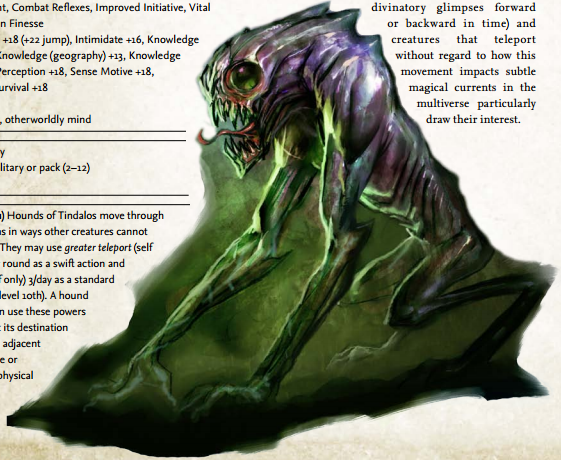
Hound of Tindalos CR 7 Medium Outsider [Evil, Extraplanar])
The Hounds of Tindalos come from a Frank Belknap Long horror short story of the same name, eventually becoming associated with the shared Cthulhu mythos. Pathfinder's hounds are cruel, cunning, and merciless terrors that actively hunt those who break the boundaries of time and space, through either time travel, divination, or teleportation "without regard to how this movement impacts subtle magical currents in the multiverse". They are constantly appearing and reappearing, being capable of casting Greater Teleport once every round a a swift action and Plane Shift 3/day as long a the destination is at a fixed angle. Someone dumb enough to attempt to mind-read or telepathically talk to a hound suffers 5d6 nonlethal damage and 2d4 rounds of confusion. For its own offensive powers, a hound has biting and clawing attacks and a gaze attack that deals 5d6 slashing damage if you don't succeed a DC 18 Fortitude save. Rather strangely for a creature that has an active "fuck the wizard" vibe to its flavor, hounds of Tindalos only have magic resistance 10 and have Dimensional Anchor as their only direct counterspell option.
Howler (CR 3 Large Outsider [Chaotic, Evil, Extraplanar])
I had originally thought that the howler was a monster created for the 3E Monster Manual, but rechecking it turns out that it was actually something back from AD&D's Planescape material. Go figure. Regardless of origins, these guys are weird emaciated monkey-cat things with skeletal heads and backs coated in quills that dwell in the Abyss. Like their devilish counterpart that is the hellcat, howlers hunt and kill prey just for the fun of it rather than to sustain themselves, but unlike the hellcats they have no sense of self-importance and status. Howlers are pure cruelty and savagery on four legs, none of that "desiring respect" business here. The howler's howl forces a DC 12 Will save to avoid succumbing to a pseudo-disease curse that deals 1 Wisdom damage per hour, and anyone that gets damaged by a howler's quills either in an offensive or defensive capacity needs to make a DC 14 Reflex save or have one of its quills break off in their flesh, which causes the target to suffer the sickened condition until someone pulls the quill out.
Ifrit (Class Level-Dependent Medium Outsider [Native])
Remember the genasi of Planescape (and later the Forgotten Realms)? Well, they're back, now with convenient new names since the genasi weren't Open Game Content! The ifrit is the planetouched of fire, being born from the union of a humanoid and an efreeti or some other being of elemental flame. On top of being red-skinned, pointy-eared, and horned, ifrits are innately pyromaniacal, impulsive, and passionate about anything they believe in. Mechanically, they've got +2 Dex and Charisma but -2 Widom, darkvision, 1/day casting of Burning Hands, fire resistance 5, treat their Charisma as 2 higher for all Sorcerer spells and clas features if they have the Elemental (Fire) Sorcerer bloodline, and cast all Fire domain spellas with a +1 to their caster level. I'm guessing you can probably already surmise what the other three elemental planetouched are going to be like.
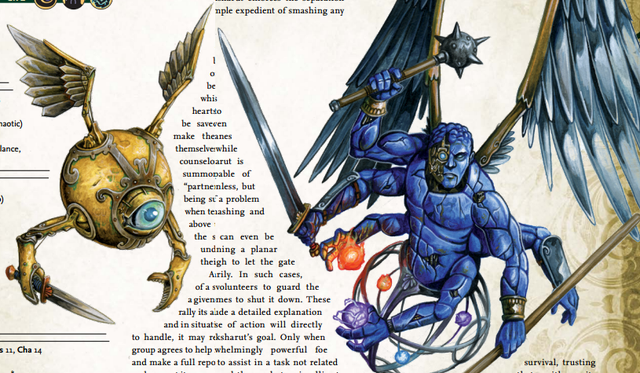
Inevitables
Ah, the inevitables. The original "the universe is knocking, and it says you're gonna die" plane police from back in the first edition of Planescape. I like the inevitables, I really do. They and the modrons are some of the few times I've seen "Law = Robot" and not been inexplicably annoyed, though that could just be nostalgia talking. That's why it's kind of sad that they lose a bit of a their oomph here in PB2. The fact that the aeons, Outsiders who do the same thing but far more inscrutably due to being uncontrollable True Neutral forces of nature, are introduced in the same title sort of dampens the effect of "oh hey the inevitables are back". I'm not necessarily against two creatures holding the same niche at all, of course, it's just that it does make the inevitables feel a bit less impactful in this case. On the plus side, there's no anhydruts here since they weren't OGC.
Arbiter (CR 2 Tiny Outsider [Extraplanar, Inevitable, Lawful])
Oh hey, it's an Outsider that is Challenge Rating 2 and size Tiny. Could this possibly mean the same thing that has meant every other time it's come up so far?
Yes, of course it does. To shoehorn in the reasoning these guys would be improved familiars in the first place, the fluff behind these vaguely modron-looking floating eyebots is that they act like little shoulder consciences that keep you from straying too far into Chaos instead of being the defenders of a universal constant. Arbiters can always sense the direction (but not distance) of its nearest superior inevitable, release a 3d6 damage electrical burst in a 10 foot radius that ha the side-effect of stunning itself for a whole day, and cast Command, Commune, Detect Chaos, Make Whole, and Protection From Chaos as spell-like abilities. They also get a +4 to disbelieve illusions created by creatures of Chaos thanks to their special eye.
Kolyarut (CR 12 Medium Outsider [Extraplanar, Inevitable, Lawful])
Kolyaruts are burly metal men in charge of dealing with those who break oaths and contracts. They prefer to wear concealing cloaks, cast Disguise Self, and pretend to be some weird mute wandering warrior until they have their prey in sight, at which point they reveal their true natures for shock value. Kolyaruts are also built with an expansive knowledge of mortal social customs and savoir-faire specifically so that they can be extremely
Lhaksharut (CR 20 Huge Outsider [Extraplanar, Inevitable, Lawful])
Six-armed and vaguely angelic inevitables, the lhaksharuts are defenders of planar segregation. While regular planar travel doesn't get their attention, trying to link two planes together for the long term or attempting to invade another plane and conquer it gets them fired up. All lhaksharuts tend to have a very blunt approach to fixing these problems and aim to either break the object or kill the person that is keeping the planar link up. Their beatdowns involve four arms wielding weapons and two utilizing special generators that can shoot a 100 foot range blast of any type of energy damage for 10d6 damage of that type, a well a spell-like abilities such as Dimensional Anchor, Dimensonal Lock, Disintegrate, Shield of Law, and Wall of Force. You can attempt to negotiate with a lhaksharut on why linking two planes for a little while is a good idea, but you'd better have your argument written in triplicate if you want to have a snowball's chance in hell of actually convincing it. When not out on murder sprees, lhaksharuts maintain a system of informants throughout the planes, giving them treasures from those it has slain in exchange for information on any potential transgressors plotting to make a mess of things.
Marut (CR 15 Large Outsider [Extraplanar, Inevitable, Lawful])
The marut is an inevitable that gets its name from a group of Hindu storm gods, and inherited from their mythological namesakes a penchant for wearing golden armor and the ability to wield the power of lightning and thunder, though the resemblance ends there. They are the inevitables that come to remind you that death is certain. Divine your own death to avoid it? That's a marut on your ass. Become a lich? Marut's coming for you. Using magic to just keep youthening yourself over and over? You guessed it, marut comes a-knockin'. They rarely speak and seldom seek allegiances with others, instead preferring to act as ever-marching forces of nature that creep up on their victims sooner or later.
Unlike other inevitables, maruts don't wield weapons, instead piledriving targets with their big onyx fists. On top of 2d6 slam damage, these punches can choose to either be a "fist of lightning" that deals 3d6 electricity damage and 2d6 rounds of blindness or "fists of thunder" that deal 3d6 sonic damage and 2d6 rounds of deafness. Maruts also have a catalogue of spell-like abilities that include Chain Lightning, Circle of Death, Earthquake, Fear, Greater Dispel Magic, and Mass Inflict Light Wounds.
Zelekhut (CR 9 Large Outsider [Extraplanar, Inevitable, Lawful])
The most coppy of the planar cops, these clockwork winged centaur guys go out to hunt people who escape the justice of their society's laws. They don't actually care about the spirit of the law so much as the letter, which means that a zelekhut won't lift a finger against a tyrannical Lawful Evil society that is technically working within its own laws but will hunt down and execute the Chaotic Good local Robin Hood figure who managed to escape the hangman's noose at the last minute. Their weapon of choice are two chains fused into their arms that deal an extra 1d6 electricity damage on top of the normal injuries and trip attacks chains are used for, and their spell-like abilities include Dimensional Anchor, Dispel Magic, Fear, and Hold Person; in case you didn't notice, there's a trend towards movement lockdown SLAs for inevitables.
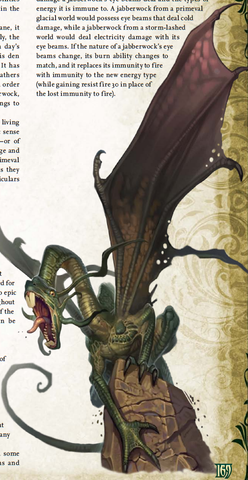
Jabberwock (CR 23 Huge Dragon [Air, Fire])
Pathfinder: a game where the nastiest critter in a book can be something from a nonsensical rhyme. Meet the jabberwock, the rabbit-toothed sewer of your demise and strongest monster in the whole of the Pathfinder Bestiary 2. This exceedingly ancient dragon comes from the primordial fairy realm, literally born from the mad dreams of the ancient fey gods, and seeks only to bring death and ruin to the Material Plane. The ancient form of magic item known as vorpal weaponry was forged specifically to cleave the seemingly impervious hide of the ancient jabberwock. Of course, even if a great hero slays the jabberwock, the fey gods will eventually slumber once more and dream of yet another one for future generations. I'm not sure where the jabberwock wins over the tarrasque in this same concept of "thing that appears once every few centuries and is extremely hard to kill", but I will admit that artist Eric Belisle does manage to give some savagery and menace to the beast without deviating too far from the classic Through the Looking Glass illustration.
Mechanically, while not as impervious as the tarrasque, the jabberwock is nonetheless built like a tank. It's got immunity to fire, paralysis, and sleep, 30 resistance to every other type of energy damage except cold (which it has a vulnerability to), 31 spell resistance, and 15 damage reduction that is bypassed by (of course) vorpal weaponry. It has a panoply of natural attacks as befitting a dragon, shoots 15d6 damage fire blasts from its eyes, creates severe wind conditions due to its "whiffling" motion during any full attack action, and has the Burble. Oh man, the Burble. This is a concentrated blast of inhuman utterances and madness-tinged nonsense in dozens of languages spoken all at once, capable of being used once every 1d4 rounds. The Burble can either be used to force a DC 31 Will save to avoid being confused for 1d4 rounds or to create a devastating 20d6 sonic damage breath weapon. As you can see in that chunk of text up by the jabberwock's wing, some jabberwocks are dream-born with different elemental affinities, which changes their immunity, vulnerability, and subtype.
Jellyfish
Jellyfish are pretty interesting. Some are miniscule, others are immense. Some float around photosynthesizing with their symbiotic algae blooms, while others are active predators that can seemingly hunt in spite of their lack of a brain to coordinate themselves. Of course, the reason they're here is because of the stings. The giant jellyfish (CR 7 Large Vermin [Aquatic]) is an active predator like its vastly smaller box jellyfish cousin, prowling the open seas for things it can entangle in its tentacles and deliver a toxin that deals 1d4 Constitution damage per round for 6 rounds. Like other giant vermin, they also get a brief table noting the names and hit dice for variations that are somewhat bigger or smaller: the Small 2 HD death's head jellyfish, Medium 5 HD crimson jellyfish, Huge 12 HD sapphire jellyfish, Gargantuan 16 HD vampire jellyfish, and Colossal 20 HD whaler jellyfish. If you want regular-size jellyfish en masse, there's also stats for the jellyfish swarm (CR 6 Diminutive Vermin [Aquatic, Swarm]), a bloom of generic jellyfish that deal 1d4 Dexterity instead of Constitution with their venom.
Jyoti (CR 9 Medium Outsider [Extraplanar])
If you asked me to imagine what the native race of the Positive Energy Plane wuld be, I probably wouldn't have guessed a bunch of anthropomorphic phoenixes. And yet, here the jyoti are. These avian xenophobes dwell in floating crystal palaces that dot their radiant plane of existence and are antitheist to a fault, spurning all gods and their followers as being distrustful at best. The only thing they hate more than the gods are the sceaduinar, Neutral Evil crystal bat people native to the Negative Energy Plane, and anyone even daring to speak their name in a jyoti's presence is likely to be assaulted. Of course, anyone in general is likely to be attacked in a jyoti's presence, as the species as a whole is very much the "our needs are the only important ones" selfishness-based interpretation of True Neutral. Jyoti have a breath weapon that deals 11d6 fire damage or 11d8 to undead, any weapon that is wielded in their hands gains the Ghost Touch magic weapon quality and deals an extra 1d6 fire damage, and they have Aid, Breath of Life, Cure Serious Wounds, Daylight, Dimension Door, Disrupting Weapon, Lesser Restoration, Mage Armor, and Searing Light as spell-like abilities.
Kelpie (CR 4 Medium Fey [Aquatic, Shapechanger])
The kelpie is a beats of Gaelic folklore, a rather monstrous water spirit that can take the form of a horse or man and isn't shy about tricking humans into being a meal. That's pretty much accurate to the Pathfinder version as well. Its natural form is a slimy horse-headed humanoid with transparent skin that exposes its skeleton and organs...lovely. There's also a few added twists, like that communities near kelpie lairs (falsely) believe that kelpies can transform humanoids into more kelpies, and that kelpies sometimes pretend to be hippocampi and let other fey ride on them safely for no reason other than because they can. The kelpie's powers are the ability to shapeshift into a horse, hippocampus, or Small or Medium Humanoid, as well as a special version of the Captivate ability that allos it to ignore the "subject snaps out of the trance if they are in danger" clause as long as the danger is the threat of drowning.
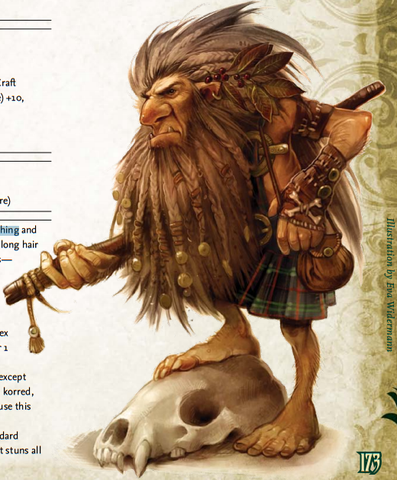
Korred (CR 4 Small Fey)
The korred, or korrigan, is a fairy from the folklore of the Bretons of northern France. You may have heard of these already if you are a fan of the Old World of Darkness, as some French-only WoD book had them as a kith for Changeling: the Dreaming and they were optioned as part of the 20th anniversary edition of CtD on its Kickstarter. You may have also heard of them from Advanced Dungeons and Dragons, wherein they appeared in 1983's Monster Manual II. It was from there that they came to the Tome of Horrors, and from the Tome of Horrors to here. Most of the fluff Pathfinder has on them is based more on the mythological end of the spectrum: they're short, they're hairy, they're strong for their size (Strength 19!), and they like to celebrate around ancient standing stones called dolmens. The only big thing on the D&D legacy side besides the stats is that korreds hang around with satyrs (the 2E Monstrous Manual declared that they were literally dwarf satyrs). As for those stats, the supernatural powers the korred gets access to are Stone Stride (Tree Stride, but with rock), a 3/day special laugh that stuns creatures that hear it for 1d2 rounds on a failed Will save, and animate hair that can be used to entangle adjacent targets.
Krenshar (CR 1 Medium Magical Beast)
Okay, this is the thing I was thinking of when I thought the howler was introduced in the 3E Monster Manual. That wasn't the howler, it was the other skullface cat creature. Krenshar are only skullfaces part of the time, though. In fact, they normally look like a panther without any external ears, and specifically peels back the sin of its face as a way of freaking out prey and potential predator alike. There's an oddly thorough ecology section for these guys as well. Male krenshars will have face-offs wherein they bare their skulls at each other to see how backs down first, females do so to males to show they aren't receptive to mating, and the retraction method also used to scrape away gore and parasites after feeding. It's a shame that a lot of other creatures in here don't get the same pleasure on account of having longer stat blocks than the krenshar does, because there are some that definitely need it.
Next Time in Pathfinder Bestiary 2: Leng spiders weave, and leprechauns brew. And there might even be a mongrelman too.
Lamia Matriarch to Mu Spore
Original SA post
Pathfinder Bestiary 2: Lamia Matriarch to Mu Spore
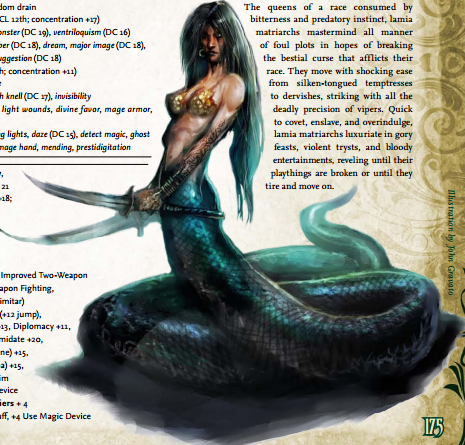
Lamia Matriarch (CR 8 Monstrous Humanoid [Shapechanger])
An upgraded version of the lamia, with a snake body rather than a lion body below her human half. I'd like to say that this might be a reference to how the history of the mythological figure Lamia – or the lamiae, as even the singularity versus plurality varies across various tellings and reimaginings – is so convoluted and her appearance frequently varies from serpentine to generically beast-like to just humanoid. Of course, the actual reason they exist is probably because of the lamia noble, the serpentine lamia leaders that have been in Dungeons and Dragons since the 1981 Fiend Folio. Also, unfortunately, the lamia matriarch really doesn't have much going for her. Other than a few buffed numbers, she really isn't all that different at all from a regular lamia, with the same Wisdom drain attack, almost the same spell-like abilities, and no really snake-related powers. Not even a constrict! What a shame.
Leng Spider (CR 14 Huge Magical Beast [Extraplanar])
Another one of the monsters of Lovecraft's Dream Quest of Unknown Kadath, the spiders of Leng are bloated purple arachnids that fought with the Plateau's "almost-men". In Pathfinders, they are similarly the enemies of the denizens of Leng, fighting against them as well as life on other planes in search of more and more slaves. Thankfully for everyone else, they are one of the very few extraplanar creatures out there that have no Dimension Door or Planeshift whatsoever, forcing them to rely on the portals of others for transport. Once they actually do get where they want to go, though, leng spiders are a terror to behold. On top of having massive spell resistance and fast healing 10, they have a venom that deals 1d4 Constitution damage plus the confusion status ailment every round for 6 rounds, can craft masterwork bolas and masterwork flails out of their webbing, and can cast spell-like abilities that include Charm Monster, Dispel Magic, Freedom of Movement, Insanity, Invisibility, and Mirage Arcana.
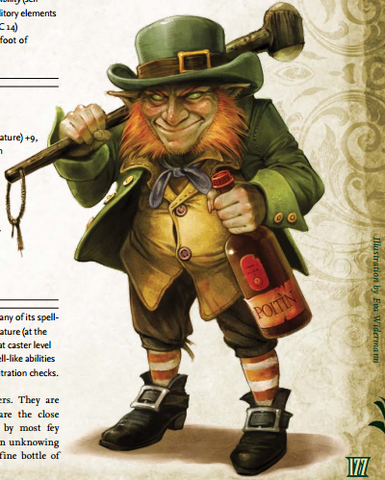
Leprechaun (CR 2 Small Fey)
I'm fairly sure leprechauns don't need much introduction. These short and solitary trickster fairies have become more or less synonymous with Ireland and caricatured into oblivion, and have been around in Dungeons and Dragons for the majority of its history. And surprise, surprise, they show up again here. Leprechauns epitomize the obnoxious little Chaotic Neutral shit-goblins that so many non-Evil D&D fey are, with pastimes that include intentionally stealing objects specifically to lead the object's owner on a chase before throwing the object back to them, spreading false rumors about being able to cast Wish in exchange for gold in order to accumulate vast hoards of wealth in their hovels, and making forests seem haunted.
Their spell-like abilities unsurprisingly include spells like Dancing Lights, Ghost Sound, Invisibility, and Prestidigitation to facilitate these tricks, as well as a constantly active Shillelagh spell on the clubs they carry. Leprechauns also get a +4 boost to their caster level on all spells if they specifically cast them with the intent to deceive, humiliate, or trick someone.
Leucrotta (CR 5 Large Magical Beast)
A monster of Roman and Medieval bestiaries, the leucrotta (sometimes spelled with just one T) was first described by our old buddy Pliny the Elder, who stated it was a beast with the body and tail of a lion, the head of a badger, cloven hooves, and bone ridges rather than teeth, which was capable of miming human speech. This is all true in Pathfinder, but on top of that it is also said that leucrottas are hyena-demon hybrids, which I guess would explain why they are Chaotic Evil. Well, that and the fact that they were Chaotic Evil in Advanced Dungeons and Dragons. The two main things the leucrotta has on its side are a bite that ignores 5 hardness of any object and has Improved Crit, as well as Mass Suggestion on its sound mimicry. Leucrottas sometimes lead packs of gnolls or crocottas, the latter of which are stated to be dire hyenas with the Advanced Creature simple template added on.
Locathah (CR ½ Medium Humanoid [Aquatic])
The locathah have been around since the beginning. Like, "the old-ass OD&D white box" beginning. Specifically, they were part of the Blackmoor supplement, which also introduced the Assassin and Monk classes and rules for swimming and other underwater activities. They've always been gillmen, but their appearance has evolved somewhat over time: a stereotypical Creature from the Black Lagoon look back in OD&D, this sort of weird codfish look in AD&D, and a face and ornamentation clearly based on the lionfish from Third Edition onward. Unsurprisingly, the Pathfinder locathah looks a lot like the 3E Monster Manual's locathah, but with the neat added flair of having the weird knobbly chest and belly plating you see on a lot of seahorse species. Pathfinders's locathah have a rather
 life: surface dwellers often loathe them because they can't tell the difference between the locathah and any of the myriad of evil fish people such as the sahuagin, so the locathah try to overcompensate by being ridiculously generous in their aid of air-breathing humanoids. Locathah clans will point out any local water hazards to passing ships, and some even lead you to sunken treasure for the nominal fee of some nice ceramic ware, metal weapons, or their favorite land snack of tubers.
life: surface dwellers often loathe them because they can't tell the difference between the locathah and any of the myriad of evil fish people such as the sahuagin, so the locathah try to overcompensate by being ridiculously generous in their aid of air-breathing humanoids. Locathah clans will point out any local water hazards to passing ships, and some even lead you to sunken treasure for the nominal fee of some nice ceramic ware, metal weapons, or their favorite land snack of tubers.
They are also extremely communical, going to almost suicidal lengths to save members of their clan if they are captured or attacked. The clan leader is a matriarch who acts as both chieftain and the only egg layer. Each adult locathah raises one of the matriarch's spawn at a time as their own. When not gathering or hunting for fish, crustaceans, shellfish, and seaweed with the aid of domesticated moray eels, locathah typically spend their time with their extended family or crafting tools and art with bone, coral, and stone. Some particularly assholish Evil seafarers are known to exploit the communalism of these fishfolk, capturing a matriarch in order to both lure in her whole clan for capture and have an ever-breeding source of new slaves.
On the mechanics side, locathahs are far less interesting than they are on the fluff end of the spectrum, having slightly higher stats than humans in everything but Strength and Constitution, +2 natural armor to AC, 10 feet land speed but 60 feet swim speed, and no real special attacks or strange abilities to speak of. Most locathah don't have class levels, but they can indeed take them, and a tribe is stated to usually have two level 1 to 3 Fighters and a level 3 to 6 Cleric for the matriarch. It's a shame that after they got so much flavor spent on them, they ended up not even appearing in the "here are some Pathfinder Bestiary series monsters, now as player races!" book that was the Advanced Race Guide; the fishy role there was instead taken by the gillmen of The Inner Sea World Guide, which I find far less interesting since they are just humans with gills and webbed digits that come from not-Atlantis and typically serve either the aboleths or the Great Old Ones.
Lurker in Light (CR 5 Small Fey [Extraplanar])
While they might resemble glowing pixies, lurkers in light aren't your typical D&D fey. Instead, these guys are horribly sadistic and violent, to a point that even some of the cruel fae of old Celtic mythology might be a bit skeeved out. These guys actually engage in humanoid sacrifice to open portals either for themselves or something they wish to summon. Lurkers have an abject hatred for anything that is connected to shadows or even just found in dark places, so subterranean species such as dwarves and gnomes get the vast brunt of their murderous rage, but their inscrutable methods are never truly predictable enough that anyone can claim to be safe.
The lurker in light has a special poison dealing 1 Strength drain followed by 5 rounds of 1d3 Strength damage that it applies to weapons it wields, has the same light invisibility that hellcats have, a 1/day use of Dimension Door between and two locations that are in areas of bright light, spell-like abilities that include Blindness/Deafness, Dancing Lights, and Daylights, and the aforementioned ritual sacrifice. The ritual sacrifice must have humanoid victims, casting a Gate spell if the right number of bodies hit the floor. It takes five sacrifices just to open a Gate specifically for traveling through for a minute, while attempting to summon creatures requires a sacrifice for every hit die that the creature or creatures would have in total. Oh, and if you kill one its body turns to special dust that counts as 2d6 flasks of holy water.
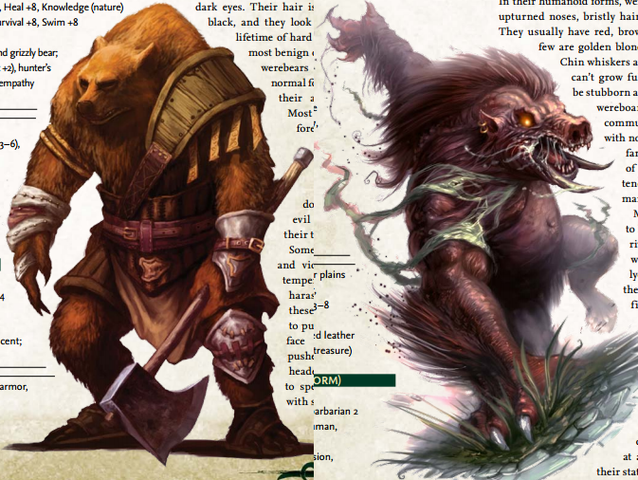
Lycanthropes
Lycanthropes are back, and they're not really better than ever because these are just the ones from the 3E Monster Manual that the first Pathfinder Bestiary didn't cover – there won't be any fully new lycanthropes until Pathfinder Bestiary 4. All of these are technically templates, but instead of actually showing a template they instead have a sample character and assume you're going to go back and read the lycanthrope rules from the Pathfinder Bestiary/SRD/wherever.
Werebear (CR +0 Template)
These guys hulk out into big ol' grizzly bears and are the only naturally Good lycanthrope. I've heard it said many a time that this is because of Beorn the bear shapeshifter from Tolkien's The Hobbit, and I'll assume that's correct rather than wrack my brains trying to figure it out otherwise (though, admittedly, lycanthrope alignment choices are usually arbitrary anyway). They are big, strapping musclefolk with red or brown hair in their humanoid form and tend to be isolationists. Most werebears will only actively engage in combat against Evil creatures in their territories, but some particularly ill-tempered ones will attack any aggressive trespasser, the most animalistic even eating transgressors.

The sample werebear is a level 4 Ranger.
Wereboar (CR +0 Template)
Crazy Chaotic Neutral pig people. They are fat and stocky in humanoid form, have large families, are so exceedingly bad-tempered and violent that even werewolves and weretigers tend to avoid them, and that's pretty much it as far as information given about them goes. The example wereboar's a level 2 Barbarian, and the stat block given already has the alterations for being in a Barbarian rage state because it's assumed that if you're fighting a wereboar they are definitely going to be activating that class feature immediately.
Weretiger (CR +0 Template)
Pathfinder Bestiary 2 posted:
Weretigers in humanoid form have large eyes, long noses, and sharp cheekbones. Most have brown or red hair, though a few have white, black, or even blue-gray. Their movements appear careful yet casual, and a person observing one could easily assume he’s watching a skilled pickpocket, graceful dancer, or sultry courtesan.
The only other things we're told about weretigers is that they are solitary and only meet to mate, and that they love to stalk and kill sapient beings because hey they're Neutral Evil. The sample one's a level 4 Rogue with a masterwork dagger, the better to gracefully dance into your spine with.
Magma Ooze (CR 7 Large Ooze [Fire])
It's an ooze, but fiery! Any weapon touching these guys needs to make a DC 19 Fortitude save or take 4d6 damage, but they're weak to cold damage and are temporarily petrified by water, so presumably the best method of dealing with one is to just dump it in a pond or something. There are a few minor variants based on what type of rock the magma ooze spawned from: brimstone magma oozes are made from fiendish energy-tainted rock and get the Fiendish Creature simple template, crystalline magma oozes are made from heavy mineral-laced rock and have bubbles in them that pop on a melee attack to deal 1d6 fire damage to the attacker, and poisonous magma oozes are made from toxic metals and have a contact poison that deals 1d2 Constitution damage per round for 6 rounds.
Mandragora (CR 4 Small Plant)
The mandragora, or mandrake, is a plant in the genus Mandrogara or the species Bryonia alba. Unsurprisingly, its vaguely humanoid-looking root with hallucinogenic properties upon consumption happens to have inspired a lot of weird folk healing and occult lore around it. Probably the most well known is the idea that it screams when pulled out of the ground, and this scream can be dangerous or even deadly. Pathfinder's mandragora a horrid little fat tree-baby that has a 2% chance of being born if a demon's corpse or ichor provides nutrients to a mundane mandrake root. It is a violent Chaotic Evil monster that spends most of its time rooted in place but viciously attacks anything that gets close to its lair. The mandragora can indeed shriek, but only once per day, and it merely forces a DC 15 Will save to avoid 1d4 rounds of being nauseated. Its root-fingers also deliver a poison that induces confusion and fatigue for 4 rounds. This poison and the mandagora's sap-blood can be mixed with 1,000GP of alchemical ingredients to buff a casting of the Scrying spell, forcing a -4 penalty on the save to resist the spell.
Megafauna
Dinosaurs not your deal? Well, no worries, there's some prehistoric mammals here for your lost world perusal as well.
Arsinoitherium (CR 7 Large Animal)
While it looks vaguely like a rhinoceros with two huge horns side-by-side on the front of its face, Arsinoitherium was in fact closer to elephants, dugongs, and manatees. They're sadly not really much different than rhinos from a game mechanics perspective, dwelling on warm plains and having the combo of powerful charge and trample special attacks. That's a shame, as the Fayum and Aydim formations that Arsinoitherium fossils are known from would have been tropical forest and coastal swamps, and the species' legs seem to be built for a semi-aquatic lifestyle. A weird hippo-rhino living on the mangroves near the beach would definitely fill a less occupied niche in Pathfinder as far as I can tell.
Glyptodon (CR 6 Large Animal)
If I had started doing this review last year, I would have said that Glyptodon is one of the most famous of the glyptodonts, a group of creatures that were superficially armadillo-like but not actually that directly related. Good thing I'm in 2016, where we now know that glyptodontines were in fact armadillos. That makes describing them much easier. So yeah, Glypdoton was a cow-sized armadillo with a weird stubby pinecone tail. It is described here as being ill-tempered and often hunted to use its shell as armor. It defends itself with +12 natural armor and a pretty vicious (1d10 damage) pair of claw attacks.
Megaloceros (CR 4 Large Animal)
Megaloceros, also known as the Irish elk, was a large deer with ridiculously huge antlers that existed in northern Europe alongside woolly mammoths and other Pleistocene standbys. We aren't told anything about them besides their name and size by the absolutely miniscule flavor text provided, but I'd like to think that they are ridden into battle for no real reason other than that it looks cool and I remember the Megaloceros being a combat unit in some prehistoric animal-themed RTS whose name I forget.
Megatherium (CR 5 Huge Animal)
The largest of the ground sloths, Megatherium lived in Pleistocene South America alongside our previous page buddy Glyptodon. In spite of its impressive 20 foot length, huge front claws, and general potential for being interesting, all we get once again are its weight, length, and a single sentence on something else (this time that it can use its tail as part of a tripod stance, like a kangaroo). This is probably why it's a bad idea to dictate that you need to keep all of a monster's entry on one page and then shove two longform 3E/Pathfinder style stat blocks, two animal companion stat blocks, and art all on that same page. Turns out that ends up nixing how much space you have for flavorful things.
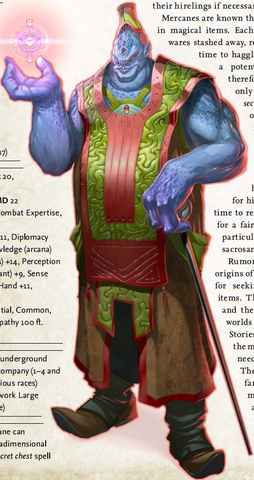
Mercane (CR 5 Large Outsider [Extraplanar])
Back in AD&D, there was a species of giant blue space elf merchants called the arcanes who were introduced in Spelljammer and later also appeared in Planescape. They returned in Third Edition, now with a new name of mercane as a presumed precaution against confusing "arcane" the race and "arcane" the magic type. Fast forward to Pathfinder, and the mercane are back, now with a new and more alien coat of paint on their physical design. Flavor-wise, though, they're still enigmatic interplanar magic item dealers. Mercanes have 3/day Dimension Door and Invisibility and 1/day Plane Shift for spell-like abilities, can make any one chest into a Secret Chest indefinitely (but it has to de-enchant the last one to enchant a new one), and wield masterwork falchions for self-defense.
Merrow, Freshwater (CR 3 Large Humanoid [Giant]) and Saltwater (CR 6 Huge Humanoid [Giant])
The name of the merrows comes from a type of merfolk from Celtic mythology, which had beautiful mermaid women and horrendous fish-ogre men. In Dungeons and Dragons, they were merely amphibious ogres. And now, in the Pathfinder Bestiary 2, they have graduated to being close relatives of ogres that actually have superior stats. They also have no mentions of rape or incest in their entry at all, which makes them superior from Pathfinder's ogres in that way as well. Merrows are communal predators that attack in packs and share their loot and food equally, raiding villages on the shoreline in the dead of night. They're also ridiculously limber compared to ogres, with Dexterity 19 on the ogre-sized freshwater merrow and Dexterity 16 on the massive 20 foot tall whale-hunting saltwater merrow.
Mihstu (CR 8 Medium Outsider [Air, Elemental, Extraplanar])
An Evil gas cloud from AD&D's Monster Cards series and the AD&D Monster Manual II, the mihstu popped up in the Tome of Horrors and thus made its way here. Mihstus seek engage in violence with misty made from their smoky bodies, rending at foes while lapping up 1d2 Constitution worth of blood every turn it has a foe pinned. The mihstu actually has no nourishnment gained from this and even spits the blood out a few rounds afterward, so it is written off as yet another case of Evil creatures doing Evil things in the flavor text. Mihstus will sometimes give information in exchange for interesting murder victims, so rakshasas, evil cloud giants, and other villanous Outsiders and extraplanar beings will sometimes team up with them.
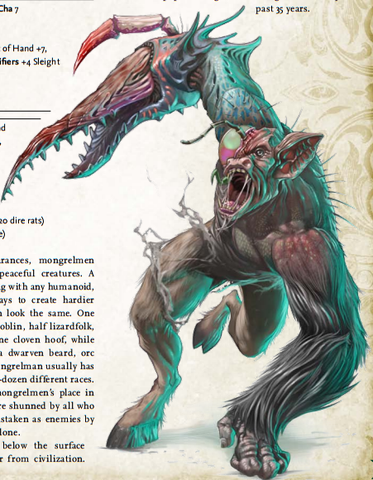
Mongrelman (CR 1 Medum Monstrous Humanoid)
Ah yes, the mongrelmen. Believe it or not, these guys were strangely popular back in the day. They first appeared in Zeb Cook's adventure Dwellers in the Forbidden City, which also gave us the yuan-ti and aboleth amongst other things, and then kept popping up in things like the Monstrous Compendium, Monstrous Manual, and even The Complete Book of Humanoids. Mongrelmen were outcast weirdos that resulted when a ton of different sapient species got down to fucking and eventually created...these things. They even showed up briefly in the early 3.0 days of Third Edition thanks to the books Fiend Folio and Races of Destiny, and they were of course part of the Tome of Horrors otherwise they wouldn't be here. These days, though, I can't really think of anyone who nostalgically sighs and goes "man, remember the mongrelmen?" outside of a certain webcomic creator and Paizo.
Mongrelmen in Pathfinder, like those that came before them, are weirdos that look like a patchwork of numerous races and live deep underground in order to avoid the numerous surface races that all shun them for being gross and ugly and maybe part of an enemy race even though they clearly look nothing at all like any single thing out there. While they live only around 35 years, mongrelmen are extremely hardy, hardworking, and docile, which makes many underground Evil races attracted to them as perfect slave labor. The mongrelmen almost never attempt to escape slavery, either, as they take a "this too shall pass" attitude to bondage.
Mechanically, mongrelmen are extremely uninteresting as they have sound mimicry and nothing else to differentiate their stat block from any other number of hardy but uncharismatic Monstrous Humanoids. The Tome of Horrors actually provided a table of randomly rolled bonuses from a mongrelman's freaky features, and the only reason I can think of for excluding it in Pathfinder Bestiary 2 is someone freaking out that it would have broken the all-sacred one page per monster at max rule.
Moonflower (CR 8 Huge Plant)
A massive Audrey II-looking plant that is typically found in small clusters. While they are True Neutral rather than any flavor or Evil, moonflowers actively refuse to speak to those that can speak with plants, even Druids, but constantly telepathically broadcast mysterious signals to each other. Attempting to crash their weird telepath party results in one's mind receiving "an assault of horrible visions of terrifying junles filled with ancient, sentient, and malign plants". Plot hook or just a weird monster plant's way of punking eavesdroppers? You decide!
The moonflower's big mechanic gimmick is that it has a special variant of Swallow Whole called Plant Prison. After swallowing someone, the moonflower pops them out as a large cocoon of vegetable matter that restricts movement and deals 2d6 bludgeoning and 2d6 acid damage per round and has a combo of 25 hit points and AC 15. If the creature inside the pod is size Small or larger and dies, 1d4 hours later a fully grown moonflower pops out thanks to the nourishment of pulped up flesh. Moonflowers can also trundle along at the speed of a halfling and release a 50 foot radius burst of light that forces a DC 20 Fortitude save to avoid 1d4 rounds of blindness.
Mosquitos
Few animals are as maligned and loathed as the mosquito: being loudly buzzing, blood-drinking (in the females, specifically), and potentially disease-carrying tends to do that. The giant mosquito (CR 6 Medium Vermin) ramps this up to an eleven by being a human-sized blood siphoning hellbeast that can murder a commoner in a round. Its 1d8 piercing damage bite attack simultaneously also deals 2d4 bleed damage, 1d2 Constitution of blood drain, a grab attack, and transmits malaria, which here is statted up as 1d3 Constitution and 1d3 Wisdom damage every day. These things are stated to naturally go after dinosaurs, dragons, and other particularly massive wildlife, but in civilized regions will lay waste to livestock and villagers. While they don't have full size range variants like some other giant invertebrates, there are two variants mentioned: the goblin mosquito (a giant mosquito with the Young Creature simple template) and the giant jungle mosquito (one with the Advanced Creature and Giant simple templates). Mosquito swarms (CR 3 Diminutive Vermin [Swarm]) have 2d6 swarm damage, 1d6 bleed damage, and malaria transmission, so just regular ol' mosquitos aren't necessarily pushovers either in the D&Dverse.
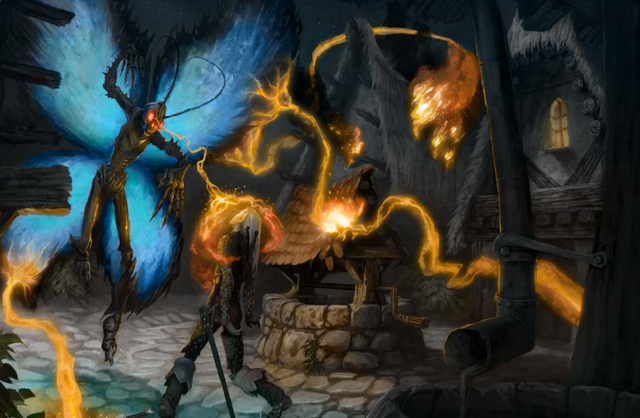
This art is from Pathfinder Presents: Mystery Monsters Revisited, not the Bestiary 2, but it seemed like a shame not to use it.
Mothman (CR 6 Medium Monstrous Humanoid)
When you think big name mystery monsters of the United States, you probably think of Bigfoot first, but for most Mothman probably isn't far behind. This frightful flying fiend supposedly menaced the sleepy West Virginia town of Point Pleasant during 1966 and 1967. While initial reports described it as a giant bird or a winged man – in both cases, the most striking feature was said to be glowing red eyes – pop culture evolution has turned it into a literal moth humanoid in a lot of depictions, and Pathfinder isn't the exception. The Chaotic Neutral mothmen here are just as mysterious as the supposed real life enigma, seeing themselves as agents of some mysterious higher fate that deliberately act out an unknowable agenda, often to catastrophic ends. What is the end goal? Who knows, it's possible that even the mothmen really know for sure. They can very easily veer wildly from a great ally to a terrible foe depending on what the circumstances at hand happen to be.
The mothman has an array of natural spell-like abilities such as Detect Thoughts, Ghost Sound, Misdirection, Nightmare, Phantasmal Killer, and Project Image, but also has a unique spell-like ability called Agent of Fate. This is a 1/day special power that allows it to create any level 5 or lower spell of any sort as an SLA, but only so long as it is deemed to steer the flow of fate. Some specific examples given include using Rusting Grasp to weaken and destroy a structure that needed to cause a catastrophe (presumably referencing the Silver Bridge Collapse on December 15, 1967, after which the Mothman was supposedly never seen again) or cast Raise Dead to bring back someone with an important destiny. It also has a 30 foot gaze attack that forces a DC 18 Will save to avoid being shaken for 1d4 rounds; if you are already suffering from a fear effect, including the one this gaze attack brings, it instead deals 1d4 Wisdom damage.
Mu Spore (CR 21 Colossal Plant)
A monster from the Epic Level Handbook and thus the SRD, the mu spore is a rare, titanic, and extremely powerful plant 100 feet in length at the very least and coated in numerous tentacles that flail around its bloated gas-filled body. These massive fungal blimps only very seldomly venture forth from their cavern lairs to rain down death and consume all in their path. And when I say rain down death, I do mean rain it: every 1d4 rounds, they can send out an eruption of spores in a 100 foot cone that rip apart any non-plant in their path with 20d8 damage. Strangely enough, mu spores also have ridiculously high mental scores of 18 Intelligence, 28 Wisdom, and 29 Charisma, and since they are Chaotic Neutral they might actually be willing to discuss matters civilly and even share their huge ranks in Knowledge (Dungeoneering, Geography, and Nature) if you can figure out how to make first contact and convince them to stop being all apocalyptic and monstery.
Next Time in Pathfinder Bestiary: We'll take a journey from N up to Q, with friends like the the qlippoth and old neh-thalggu.
Necrophidius to Quickwood
Original SA post
Pathfinder Bestiary 2: Necrophidius to Quickwood
Necrophidius (CR 3 Medium Construct)
A creature originating from White Dwarf magazine, Games Workshop's simultaneous foray into AD&D and promo magazine for its own materials, the necrophidius is a golem created by putting a fanged humanoid's skull on the end of the skeleton of a large snake. Why? Who knows, wizards are strange and frightening folk. For whatever reason, these guys were apparently really popular, appearing again in 1981's Fiend Folio, the Tome of Horrors, and now here. Pathfinder also gives us a "Prepare to be Edgy" variation on the necrophidius's description, wherein some creators use the head of one of the loved ones of the person they're trying to assassinate to make the necrophidius, flayed skin and all. This bone snake's main methods of fighting are a full round dance that forces a DC 15 Will save to avoid being dazed for 2d4 rounds and a bite that delivers a venom that paralyzes for 1d4 rounds on a failed DC 13 Fortitude save.
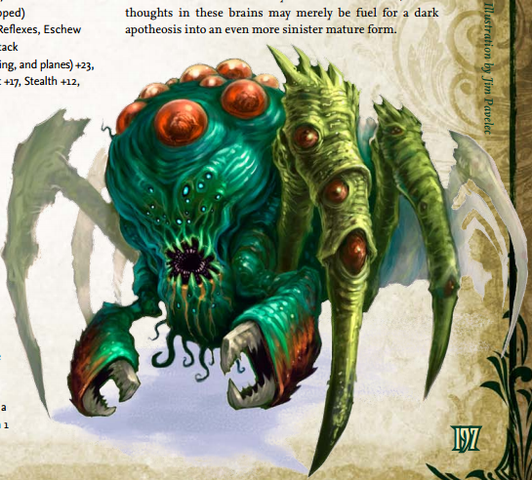
Neh-Thalggu (CR 8 Large Aberration)
A creature from Mystara and later the Far Realm tied to Greyhawk and the Forgotten Realms, the neh-thalggu is basically a giant head on spider legs that collects humanoid brains to augment its own sorcerous power. While the Open Game Content version is the super-powerful elder neh-thalggu of the Epic Level Handbook, Pathfinder actually eschewed just reusing that stat block and instead created this weaker creature more on the power level of the classic AD&D one. Of course, weakness is relative in this case, as it's still an eldritch abomination that come out of somewhere in deep space to hunt for brains. Its natural weapons are crab claws which scoop out your brain on a coup de grace and a bite with venom that deals a 1d2 Strength damage and staggered condition each round for six rounds, but far more dangerous and unpredictable is the fact that it can learn and cast spells as if it was a level 7 Sorcerer. A neh-thalggu is assumed by the stats to always have a full cargo of seven fuel-brains (as well as whatever brains it is carrying to wherever neh-thalggu carry brains), but loses a caster level and gains a negative level for each brain below seven it has.
Nereid (CR 10 Medium Fey [Water])
Originating in the annals of Greek mythology, the sea nymphs known as the nereids have been around in D&D since 1980. And, once again, our friend the Tome of Horrors means that they are reproduced in their old school form here in Pathfinder. In particular, this means that we have a Chaotic Neutral creature who is totally down with murder:
Pathfinder Bestiary 2 posted:
Nereids are capricious and often dangerous aquatic fey that appear as strikingly beautiful women, often seen bathing unclothed in the water. Many sailors have met their doom following a nereid, for though a nereid’s beauty is otherworldly, her watery kiss is death.
If you steal a nereid's clothes, she takes 1d6 Constitution damage for an hour and begrudgingly follows your commands as a cover for her eventual attempt to murder you and take her clothes back.
Nightshades
A collective of creepy critters dwelling in the confluence of the Plane of Shadow and Negative Energy Plane. They are born when a demon gets the idea that they can harness negative energy directly from the source and get eaten alive by the forces of pure entropy, ripped apart and reborn as these shadow-like undead. Nightshades go on gathering souls of immortals such as fiends and celestials and throwing them into the entropic void, and when the soul count reaches "critical mass" (whatever that means for souls) they form yet another new nightshade as well. They also gobble up mortal souls because why not go for gold on consumption. All nightshades have an aura of Desecrate with a 30 foot radius, natural attacks that deal an extra 4d6 cold damage, and the weakness of being sickened by bright light.
Nightcrawler (CR 18 Gargantuan Undead [Extraplanar, Nightshade])
Big umbral centipedes with loads of glowing red eyes all over. The book tells us in rather loaded language that while "it would be one thing if the nightcrawlers remained in the deep caverns, for these regions are rife with foul life the world is better without", the big shadow bugs crawl out of the depths in the dead of night to scour the surface world. And scour they can, with the ability to bestow a negative level each round they have someone swallowed, a 9/day power that channels 9d6 negative energy damage, and a load of spell-like abilities including a constantly active Magic Fang, Contagion, quickened Cone of Cold, Finger of Death, and Summon (6 Greater Shadows).
Nightwalker (CR 16 Huge Undead [Extraplanar, Nightshade])
These guys look like your stereotypical demon if he got hit by a grayscale filter and make up the vast majority of nightshade forces. Nightwalkers lead legions of shadows into battle against mortal armies and love to make foes suffer before they are absorbed into the void, usually by breaking valued treasures and killing loved ones. Nightwalkers have an 8/day 8d6 negative energy channel, claws that can make sunder attempts as a swift action, and most of the same SLAs as the nightcrawler.
Nightwave (CR 20 Colossal Undead [Aquatic, Extraplanar, Nightshade])
The largest and most powerful of the nightshades is the nightwave, an immense shadow shark that normally plies the deepest ocean trenches but can also fly because fuck you. While it has Intelligence 22, the nightwave lacks the tactical decision-making of the nightcrawler and nightwalker, instead being a massive eating machine that desires only to devour without end. A nightwave deals two negative levels a round to a swallowed foe, exudes a 60 foot radius aura when in water that inflicts Deeper Darkness and 6d6 damage that is half cold and half bludgeoning, has a 10/day 10d6 negative energy channel, and has most of the spells of the nightcrawler plus some fun extras such as Wail of the Banshee and Summon (1 Nightwing).
Nightwing (CR 14 Huge Undead [Extraplanar, Nightshade])
Another nightshade that shares its name with a superhero, the nightwing is a giant shadow bat that is probably the most assholish of the nightshades to fight even though it's technically the weakest. You see, rather than dealing negative damage, this guy's specialty is a bite attack that can temporarily render a magic item useless and attempt to sunder it or suck away a spell that has been cast on the bite victim. This means that it is almost tailor-made as a colossal middle finger to any warrior with a Cleric or Wizard buddy buffing them and/or using magic weapons and armor. Beyond that it's mostly just another nightshade, having 7/day 7d6 negative energy channeling and yet again most of the same spells seen on the nightcrawler.
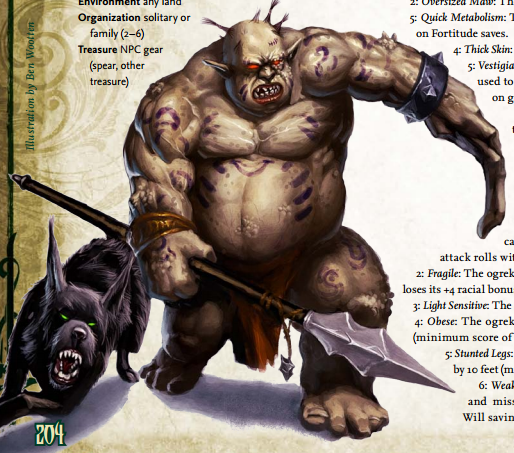
Ogrekin (CR +1 Template)
Pathfinder Bestiary 2 posted:
The result of an unfortunate union between an ogre and a humanoid, the ogrekin (or half-ogre) is cursed with horrific malformations due to its tragic ancestry. Shunned by both parents, ogrekin tend to form unstable clans of their own, often resorting to inbreeding to sustain the collective. While good-natured ogrekin are not entirely unheard of, they are far and few between.
 Why do we have to go back to the inbred rape hillbilly well?
Why do we have to go back to the inbred rape hillbilly well?
This template can only be applied to size Medium Humanoids, too, so you can't even have a half-ogre of another giant species. The template grants +3 natural armor, +6 to Strength and +4 to Constitution but -2 to Intelligence and Charisma, and randomly gives one beneficial deformity and one detrimental deformity. On the boons sides, you can get a bite attack, +2 bonus to Fortitude saves, +2 natural armor, vestigial third arm that grants a +4 to grapple checks but can't hold items, or a deformed twin head that has no brain but provides 360 vision, while on the banes you can get a deformed hand that causes a -2 penalty to attack rolls with two-handed weapons, don't gain the template's normal bonus to constitution, light sensitivity, -2 to Dexterity from morbid obesity, -10 feet of base speed due to stunted legs, or -2 to Will saves from a bulbous deformed head.
Oread (Class Level-Dependent Medium Outsider)
A fair number of letters after the ifrit, we get our second genasi with the serial numbers filed off. Oreads are stone-colored but not actually tough-skinned people that have the usual stereotypes related to earth beings – quiet, slow to anger but dangerous when riled, etc. etc. Being an oread nets you +2 Strength and Wisdom but -2 Charisma, darkvision at 60 feet, a 1/day use of the Magic Stone spell, acid resistance 5, and two extra effective points in Charisma if you have the Earth Elemental Sorcerer bloodline or +1 caster level to Earth domain powers and spells as a Cleric.
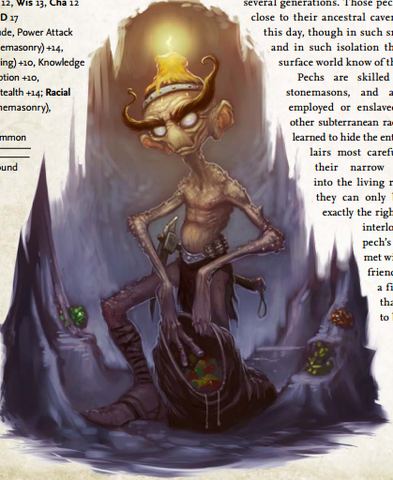
Pech (CR 3 Small Fey [Earth])
While this monster's name originated in one of the many dwarf-like faeries of Gaelic mythology, and its stats came to us through the AD&D Monster Manual II and Tome of Horrors, the pech of Pathfinder gets its own story. Namely, these guys are the ancestral form of the derros, and the few pech that left are isolationist weirdos that rarely leave their ancestral caves because they are afraid that there will be a one in a million chance they'll suffer the same fate as their demented brethren. And...that's about it, really. Four pechs in a group get a 1/day casting of Wall of Stone, while eight in a group get a 1/day of Stone to Flesh.
Peryton (CR 4 Medium Magical Beast)
The peryton is a weird monster with a weird real world history. Folklorist Jorge Luis-Borges created them in his title The Book of Imaginary Beings with the backstory that they had been chronicled by a rabbi who had heard of ancient Greek legends concerning them, though in the time since there have been (almost certainly incorrect) individuals who have claimed that Borges didn't create them and they were in fact actual figures in Greek mythology. Regardless of their origin, the peryton's description is clear: a merciless winged deer that has the shadow of a man until it kills a human being, at which point it gains its own shadow. Pathfinder's perytons change this up by having their own shadows from the start and instead kill people just because they're Chaotic Evil, which is clearly better. In spite of the fact that all perytons hate every living thing including other perytons, females live in large flocks that prey on any creature weaker than themselves, with humanoid hearts being particularly savored. Bachelor males typically only meet these small flocks when they attempt to steal a meal or steal a mate. Said mating is short, violent, and usually ends in the male being eaten, the female laying a single egg that hatches seven months or so later.
Mechanically, perytons have human intelligence but not much strategy to speak of, just engaging in violence with their antler gores and hoof strikes. They can copy a foe's shadow to gain a +2 morale bonus to attack and damage rolls against said foe and also forces a DC 13 Fortitude save to avoid being shaken for a round any time they kill on a critical hit due to the flavor that they rip out a foe's still-beating heart during such a kill.
Petitioner (CR 1 Outsider/Template)
Petitioners are what a soul becomes after death but before either transforming into a planar Outsider (demon/devil/angel/azata/etc.) or going back into the lifestream. Their memories of their life in the mortal world have begun to fragment but haven't completely been erased yet like they are in a planar Outsider, but in the end this doesn't really matter as all they really do is engage in some form of placation or suffering depending on what plane they're on. Petitioners in Abaddon are known as hunted and are constantly stalked and eventually eaten by or turn into daemons, those in the Abyss are known as larvae and feed on enough demon shit to become demons themselves, those in Elysium are called the chosen and enjoy various pleasures before becoming azatas, those in Heaven are referred to as the elect and aid in various tasks before they turn into archons, the ones in Hell are "the damned" and are heavily scarred from constant torture that only ends when they are decided to be fit enough to become devils, those of Limbo are called the shapeless and are basically depressed ghosts that wander around feeling sorry for themselves until they become proteans, ones in Nirvana are named the cleansed and become animals based on their personality before transforming into agathions upon some manner of enlightenment, those in Purgatory are just called "the dead" and sit around being skeletal until they transform into aeons, and those whose afterlife is Utopia are referred to as "the remade" and get to be reforged as inevitables after they have solved the riddle of arcane script written all over their own soul-bodies.
I hesitate to actually call this one a template, really. It's almost a pseudo-template in that you get stripped of almost all your defining class features and special qualities, drop down to 2d10 hit dice no matter how many you had in life, change type to Outsider, and have a Challenge Rating of 1. Really, the only thing that a petitioner keeps is its size modifier and ability scores. Each one also gets one or two minor abilities on top of their blank slate. The hunted get damage resistance 5 and fast healing 1, larvae have cold, electricity, and fire resistance 10 plus a bite attack, chosen have cold and fire resistance 10 plus +2 Charisma, elect get a fly speed equal to their base speed, damned have immunity to fire damage but still suffer its pain (this requires a DC 15 Fortitude save to avoid being stunned 1d4 rounds every time they would normally take fire damage), shapeless have the Incorporeal subtype, cleansed have cold and sonic resistance 10 plus +2 Wisdom, dead have damage resistance 10 bypassed by bludgeoning damage plus cold immunity, and remade get +2 Intelligence and an immunity to hostile transmutation.
Phycomid (CR 4 Small Plant)
Phycomids first came to us in the December 1982 issue of Dragon magazine, later appearing in the AD&D 2 Monstrous Manual, the Tome of Horrors, and here. They're not all that interesting, to be honest. A phycomid is a green mold monster with a bunch of mushrooms growing out of it. They spit acid and throw spores that inflict a disease dealing 1d2 Constitution damage a round for 6 rounds. If you die to a phycomid, another phycomid grows from the nutrients of your corpse.
Poltergeist (CR 2 Medium Undead [Incorporeal])
Poltergeists are special incorporeal undead that are bound to the place of their death or the location their corpse was interred, unlike the wander-capable ghosts and the various other phantasmal spiritse you usually encounter in the Pathfinder universe. This captivity has tormented them and twisted their minds until they have become merciless and evil (Lawful Evil, oddly enough) creatures that lash out in a rage at any living thing they come across. Unfortunately for the poltergeists, they can't actually directly attack, not even a cold touch or anything. Instead, the poltergeist has a set of gimmick options for use in combat: it can take a standard action to briefly go from its normally invisible state to show itself as a skeletal corpse and force a DC 14 Will save to avoid being frightened for 1d4 rounds, or it can use its constantly active Telekinesis spell to throw shit. A slain poltergeist reforms in 2d4 days if you don't correct whatever keeps it bound to the mortal coil.
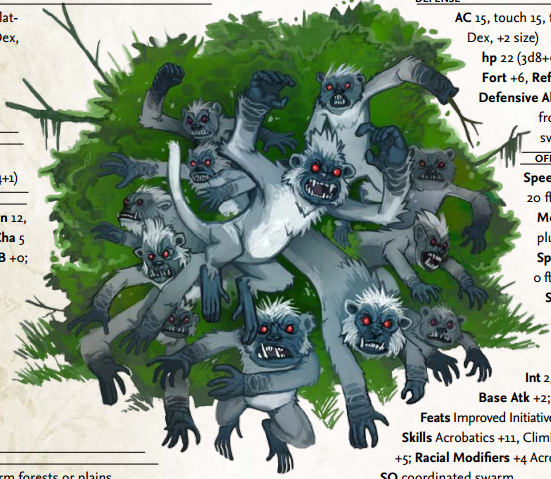
Primates
The order that includes lemurs, monkeys, gibbons, great apes, and ourselves; this entry is specifically two monkey stats. Baboons (CR ½ Small Animal) are aggressive savannah-dwelling omnivores, while monkey swarms (CR 2 Tiny Animal [Swarm]) are hundreds of angry jungle-dwelling monkeys that descend from the trees to deal damage upon your starting heroes.
Proteans
Meet our slaad equivalent for Pathfinder. Creatures of primordial Chaos, the proteans are a clan of Chaotic Neutral snake-like monsters that dwell in the swirling madness of Limbo. They believe that the gods wronged them by pulling the clay to make the other planes from out of the primordial chaos, and seek to correct this injustice by sucking everything and everyone back into what they see as the glorious incongruity of their realm. All proteans have flight, blindsense, acid immunity, electricity and sonic resistance 10, constrict attack, continuously active Freedom of Movement spell, constantly-shifting organs that grant an immunity to unwilling polymorph effects and 50% chance to ignore any extra damage from critical hits or sneak attacks as well as an always one round only recovery time for blindness or deafness, and a 1/day use of either Polymorph (for CR 9 or lower) or Greater Polymorph (CR 10 or higher) that also works as the Heal spell. Some proteans can also utilize what are known as warpwaves, which is a special attack that rolls d20 and randomly inflicts some manner of damage or ailment. This can be two points of damage to one ability score, a negative level, 1d4 rounds of a combat condition such as entangled, sickened, or blinded, instant fatigue (or exhaustion if they were already fatigued), 4d6 temporary HP, a Heal spell, a Flesh to Stone spell, a Baleful Polymorph spell, or 4d6 damage from one of the types of energy damage.
Imentesh (CR 10 Large Outsider [Chaotic, Extraplanar, Protean, Shapechanger])
"Chaos missionaries", the imenteshes are bright blue proteans with snakey lower bodies, clawed humanoid torsos, and heads like some weird toothed parrot that slither out from Limbo to preach about how great unraveling reality would actually be. While they prefer to talk with their constantly active Tongues spell, combative imenteshes can call on a +4d6 sneak attack, spell-like abilities that include Chaos Hammer, Dispel Magic, Major Creation, Polymorph Any Object, and Slow, and the ability to slap a warpwave on anyone within 100 feet who fails a DC 20 Fortitude save as a standard action.
Keketar (CR 17 Large Outsider [Chaotic, Extraplanar, Protean, Shapechanger])
Large and in charge, the vibrantly colored keketars have stork-like heads and lots of spikes all over their bodies. They are the priesthood of the protean people and deliver messages from their god about the sacred mission to bring all back into the fold of primordial chaos. They have a 30 foot radius "spacial riptide" that forces any non-protean teleporting in or out of that aura to make a DC 28 Fortitude save or be put in suspended animation for 1d3 rounds, a 1/day power that acts as a buffed Mirage Arcana spell that creates semi-real illusory terrain features that have hit points and can deal damage, and spell-like abilities that include Chaos Hammer, Major Creation, Move Earth, Prismatic Spray, and Prismatic Sphere. Oh, and any claw or bite attack they make forces a DC 28 Fortitude save to avoid being affected by a warpwave.
Naunet (CR 7 Large Outsider [Chaotic, Extraplanar, Protean, Shapechanger])
Primitive, violent proteans that resemble linnorms, naunets are unleashed to sew chaos in the good old-fashioned manner of destruction and violence. Their mechanics to support this life calling are natural weapons that count as magic and chaotic weaponry for overcoming damage reduction and can further freely switch between one of adamantine, silver, or cold iron on top of that, as well as the two tentacles on its back delivering a chaotic energy that forces a DC 19 Will save to avoid being confused for a round. Three naunets in a group have a 1/day casting of Solid Fog, while six or more can instead cast Acid Fog.
Voidworm (CR 2 Tiny Outsider [Chaotic, Extraplanar, Protean, Shapechanger])
A CR 2 Tiny Outsider, you say? That can only mean one thing: the prerequisite familiar-capable Outsider that every other group has had in this book! In the wilds of Limbo, these iridescent feathered serpents flit around in large schools, but typically end up being summoned by wizards that specialize in illusions and evocation. Other proteans claim that voidworms aren't true proteans as they are too weak and no proper protean would ever allow itself to be summoned and bound, but the voidworms don't really care about such insults due to having short attention spans and near-constant curiosity for new things. They have a handful of spell-like abilities such as Dancing Lights, Ghost Sound, and Prestidigitation, and their weak tail slap attack forces a DC 12 Will save to avoid a round of being confused.
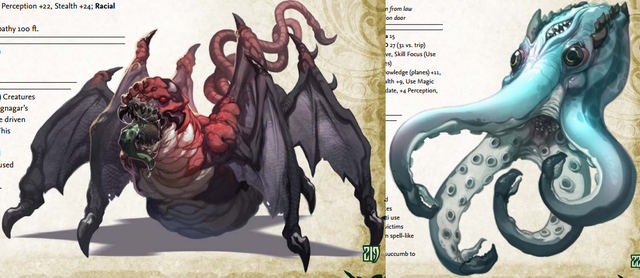
Qlippoths
The name "qlippoth" has its origins in Jewish and hermetic Kabbalah mysticism, referring to the impure/evil shells that constrain the divine illumination of the ten sephirot. This has nothing to do with Pathfinder's equivalent beyond the overarching name, however; instead, to learn of the origins of these qlippoth, we must look to the history of roleplaying games. D&D Third Edition, specifically. Green Ronin Publishing created a third party sourcebook called the Book of Fiends that was full of "edgy" and grotesque demons, devils, and other Evil Outsiders, one group of which were the qlippoth. Green Ronin's qlippoth were the ur-Chaotic Evil that formed in the Abyss before demons and possibly even the gods existed. Someone at Paizo apparently quite liked this idea, as the Book of Fiends gets the honor of being the only third party title besides the Tome of Horrors I and II that got combed for Pathfinder Bestiary 2, and it's for that reason that we have this entry.
As in BoF, Pathfinder's qlippoth are a truly ancient Chaotic Evil race, quite literally from the dawn of time, that have become incensed with demons taking over their pad. While at first the qlippoth engaged in a mass war against demonkind, they eventually put two and two together and realized that demons would just keep coming as long as mortals keep sinning. Their solution? Extermination of all mortal life in the multiverse. It's the only way to be sure! A qlippoth in the Material Plane will veer right for children and pregnant women first, because that's just the way they roll when it comes to thinning down potential future demons. There are a handful of nihilistic qlippoth worshipers out there, but not nearly as many as there are for demons, and even what few there are actually pose a problem for the qlippoth. Namely, a qlippoth can be "infected" by mortal worshipers' sins and transformed into demon lords. It is stated that most non-humanoid demon lords such as Dagon and Jubilex were originally qlippoth.
Mechanically, all glippoths share an immunity to cold, mind-affecting effects, and poison, acid, electricity, and fire resistance 10, telepathy, and an ability called Horrific Appearance that is always a mind-affecting gaze attack with a Will save attached but has different effects on a failed save depending on the particular qlippoth.
Augnagar (CR 14 Huge Outsider [Chaotic, Evil, Extraplanar, Qlippoth])
The big, dumb brute species of qlippoth. These weird bat-spider things guzzle up rotting demon flesh, other qlippoths, and whatever else happens to get in their way. Once an augnagar consumes enough other qlippoth that is is immensely bloated, it engages in self-mutilation that allows it to be reborn from its own viscera as a more powerful species of qlippoth called the thulgant. In the meantime, they are still pretty nasty, their bite and claw attacks having both 1d8 extra bleed damage and the bite alone having a further "rotting curse" disease that deals 1d6 Constitution drain and a variant of the Stench special quality that also affects the rotting individual as much as it does any bystanders. Their Horrific Appearance deals 2 Charisma damage and 1d3 rounds of confusion.
Chernobue (CR 12 Large Outsider [Chaotic, Evil, Extraplanar, Qlippoth])
A big slimy eyeball with tentacles. They love being dirty boys that spread the "vile fecundity of the Abyss" across the multiverse, using their 1/day Plane Shift to plop down in a different spot of the cosmos and bring misfortune each day. Chernobues have a 30 foot radius misfortune aura that forces a -1 to attack rolls and damage rolls to creatures that are either Lawful or Good (this boosts to -3 if you are Lawful Good), venom on their bite attack that deals 1d2 Constitution drain a round for 6 rounds, and Horrific Appearance that deals 2d6 rounds of paralysis on a failed save.
Cythnigot (CR 2 Tiny Outsider [Chaotic, Evil, Extraplanar, Qlippoth])
Okay, I know literally every Outsider clan has had the CR 2 Tiny member who is meant to be used for an improved familiar, but this one is a bit much. Qlippoth are specifically anti-worship and anti-mortal. This is gotten around by having the cythnigot being a fungal parasite that infects Tiny size animals, and a familiar one being an intentional creation of a Chaotic Evil Wizard infecting their familiar with cythnigot spores. The result is a deformed version of the original animal carrying a slimy Venus flytrap on its back (which is also what "wild" individuals will look like). The cythnigot's Horrific Appearance sickens for a round on a failed save. Furthermore, its bite forces a DC 11 Fortitude save toa void being infected by spores that wrap around the target's limbs and impart the entangled condition until a successful save on a round allows the target to rip them out.
Iathavos (CR 20 Colossal Outsider [Chaotic, Evil, Extraplanar, Qlippoth])
The iathavos resembles a massive eye-covered sphere with four bat wings and two clawed legs, frequently covered in numerous smaller and weaker qlippoth that swarm over its hide. It is a disaster on the wing that razes mortal and demon habitations alike and only disappears in a Plane Shift when it has either completely depopulated a city or is driven away by a foe that can actually outmatch its combat prowess. Like the jabberwock earlier on in the book, slaying the iathavos is only a temporary measure, as another is soon born fully formed and ready to begin planning future destruction.
Unsurprisingly, the iathavos has a large amount of mechanical powers it can call on. Perhaps the most insidious is Abyssal Transformation, wherein a grappled creature gets engulfed and must make a DC 30 Fortitude save or be transformed into a nyogoth qlippoth that blindly serves the iathavos. If that wasn't enough, it has constantly dripping ichor in an expanding radius (5 feet after the iathavos is first injured, at which point it expands 5 feet per round to a max of a 30 foot radius) that entangles on a failed DC 32 Reflex save and deals 4d6 acid damage a round to entangled foes, Horrific Appearance that both casts Feedlemind and induces permanent blindness on a failed save, 300 foot range eye beams that deal 40d6 damage and can be used once per minute, and a suite of spell-like abilities that include constant Cloak of Chaos and Freedom of Movement, at will Plane Shift, Black Tentacles, Horrid Wilting, Imprisonment, and Word of Chaos.
Nyogoth (CR 10 Medium Outsider [Chaotic, Evil, Extraplanar, Qlippoth])
Nyogoths are relatively weak qlippoth that resemble floating mouths covered in intestine-tentacles. They are the scavengers of the Abyss, eating waste and filth that demons and qlippoth leave behind as well as any unfortunate living creatures they can overpower. While technically as smart as a human, the nyogoth's ceaseless hunger overrides everything else, and their only shows of cleverness are in figuring out how to get more food. A combatative nyogoth has a Horrific Appearance that nauseates for 1d8 rounds on a failed save, and its body is so stuffed with acid that any piercing or slashing damage spews 1d6 damage worth of acid in all adjacent squares.
Shoggti (CR 7 Large Outsider [Chaotic, Evil, Extraplanar, Qlippoth])
These squid-like qlippoth are keen-minded slavers. What does a nihilistic bunch of monsters that desire nothing more than to eliminate all mortals and demons need with slaves? Nobody's sure, beyond that it's probably short-term murder avoidance for long term murder gain. The shoggti's four claws can somehow hold magical items but not weapons, however that works. They can also do a melee touch attack that deals 1d4 Wisdom damage once per round, a Horrific Appearance that renders those who fail against it fascinated for 1d6 rounds, and spell-like abilities focused on mental manipulation such as Charm Person and Command.
Thulgant (CR 18 Large Outsider [Chaotic, Evil, Extraplanar, Qlippoth])
Trading wings (but not their flight, because why not) for three scorpion stingers, superhuman intelligence, and a load more supernatural and physical powers, the thulgant is what comes out of an augnagar after it goes on a cannibal binge. Thulgants are the anti-demon warlords of the qlippoth and engage in merciless campaigns against them. Hell, they're so good at fighting demons that all of their attacks are treated as cold iron and good-aligned when injuring demons and any spells they cast against a demon get a +10 bonus to penetrating spell resistance. Their three stingers can force a DC 29 Fortitude save to avoid 1d4 Strength, Dexterity, or Charisma drain depending on which of the three tails struck, and if all three successfully hit a target in the same round there's an additional 3d6+12 damage and a DC 29 Fortitude save to avoid 2 drain on all six of the victim's ability scores. For supernatural powers, the thulgant has a Horrific Appearance that deals 1d6 Wisdom damage and 1d4 rounds of stun on a failed save and spell-like abilities including at will Greater Dispel Magic, quickened Dimension Door, Flesh to Stone, Temporal Stasis, and Word of Chaos.
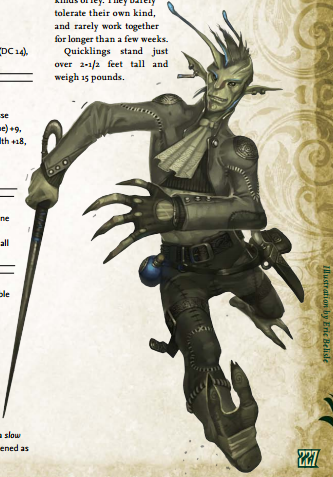
Quickling (CR 3 Small Fey)
Originating in the 1983 Monster Manual II, the quicklings of yore were vicious elf-like fey created by the Queen of Air and Darkness via twisting and corrupting brownies. They were also ridiculously short-lived for a sapient race, only lasting ten years due to the fact that they go so fast. They are still described as looking like little elves here – though apparently someone didn't tell the artist about that, since he created the interesting and rather alien-looking faerie rogue we have above – but the origin story with the queen is gone, as is any mention of a short lifespan due to their speed powers. Quicklings like being assholes, murdering, and murdering while being assholes: the only things that really bring them joy are insult and violence. As their name implies, a quickling is exceedingly fast, having a 120 foot base land speed and gaining 20% concealment due to the blur effect around them as they move. Oh, and they're invisible while motionless too. A quickling that is hit by the Slow spell or effect that replicates it both loses their blur effect and is sickened for the duration of the spell and a round after.
Quickwood
Another creature from the AD&D 1E Monster Manual II, the quickwood is an angry tree with a face and vine tentacles. I guess being able to move at all is quick by tree standards, but it's a shame it isn't literally zooming around the landscape or something. Quickwoods can see through any oak tree within a 360 foot radius and can store one spell that its spell resistance protects against. It technically has a fear aura, but has to use a stored spell charge to produce a one round "burst" with a radius of 10 feet per spell level of the stored spell. Failing a DC 20 Will save means any target in the radius is panicked for a minute.
Next Time in Pathfinder Bestiary 2: We're closer to the finish now, it's time for R and S. We'll meet the rasts and reefclaws...oh, and slime molds too, I guess.
